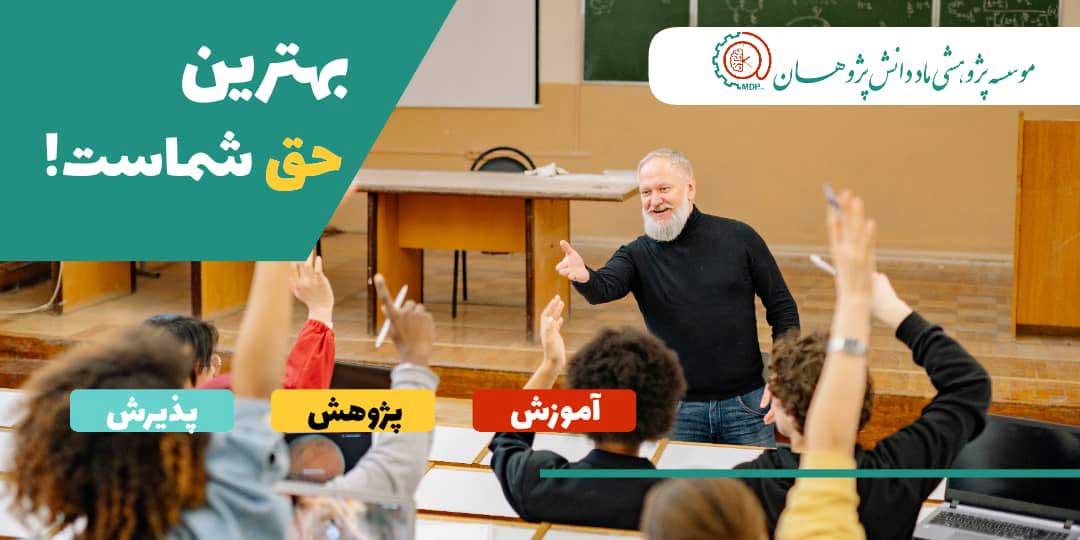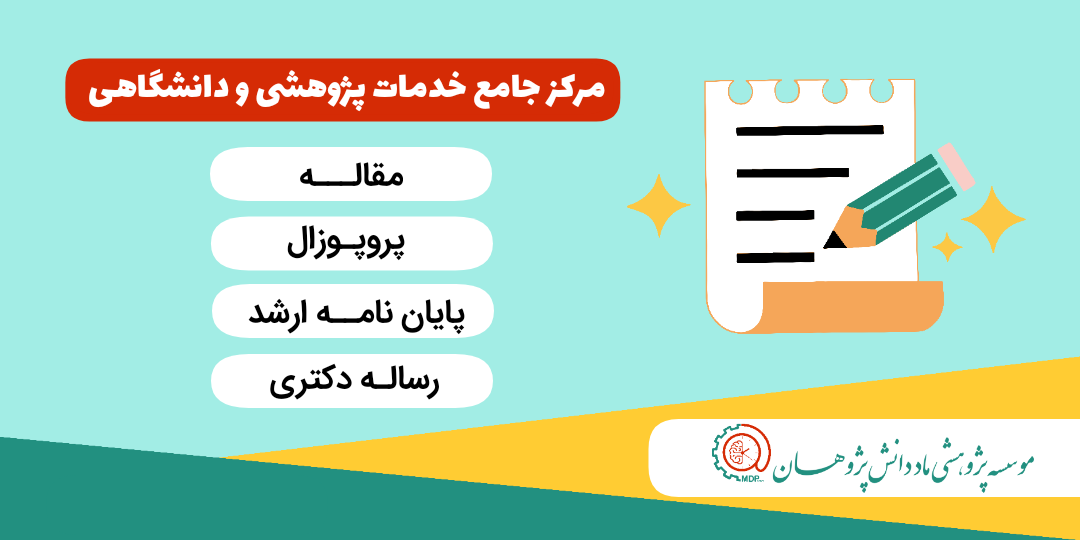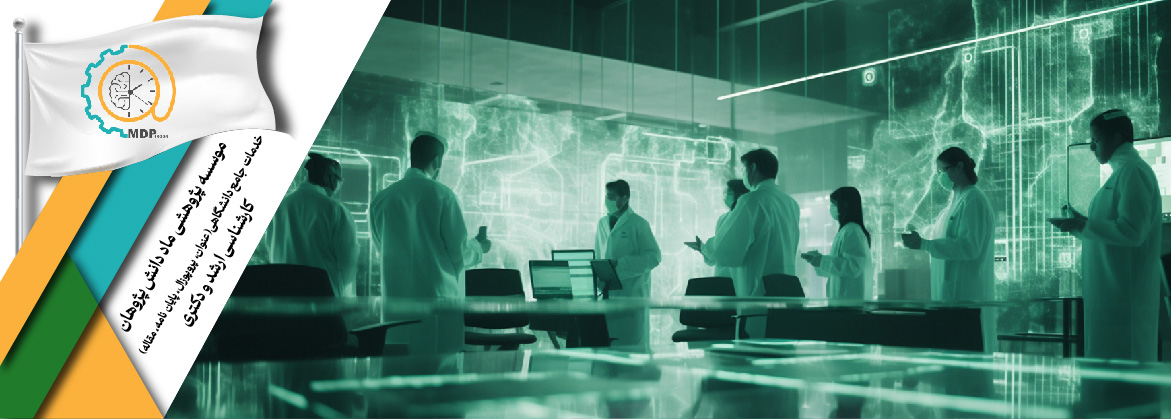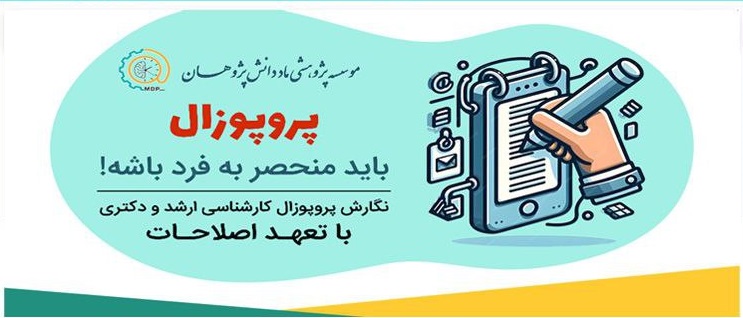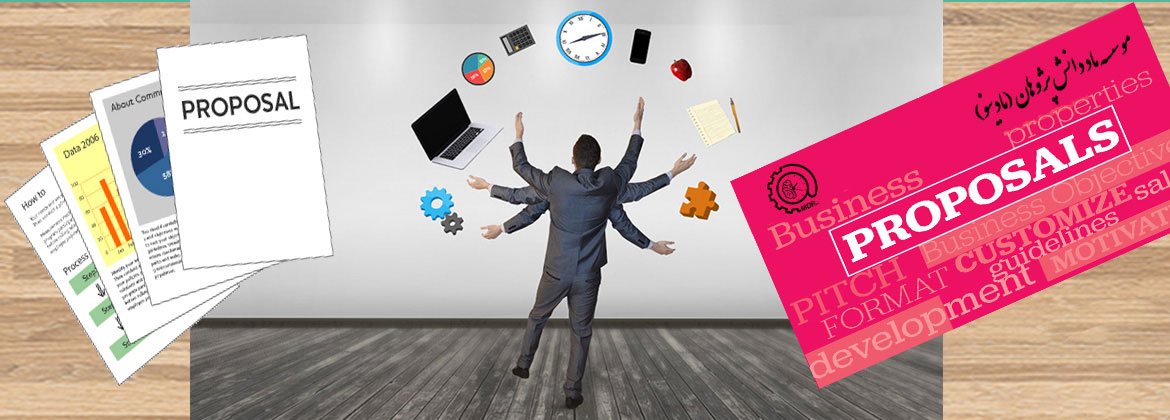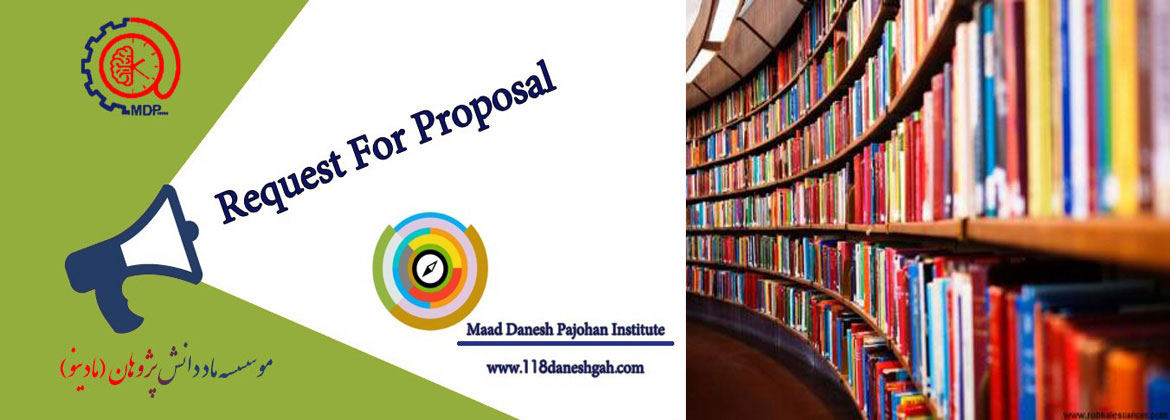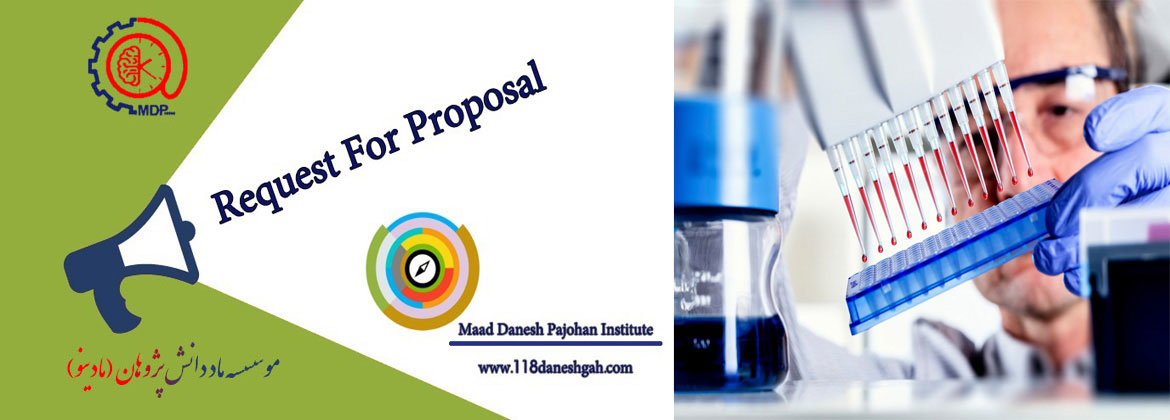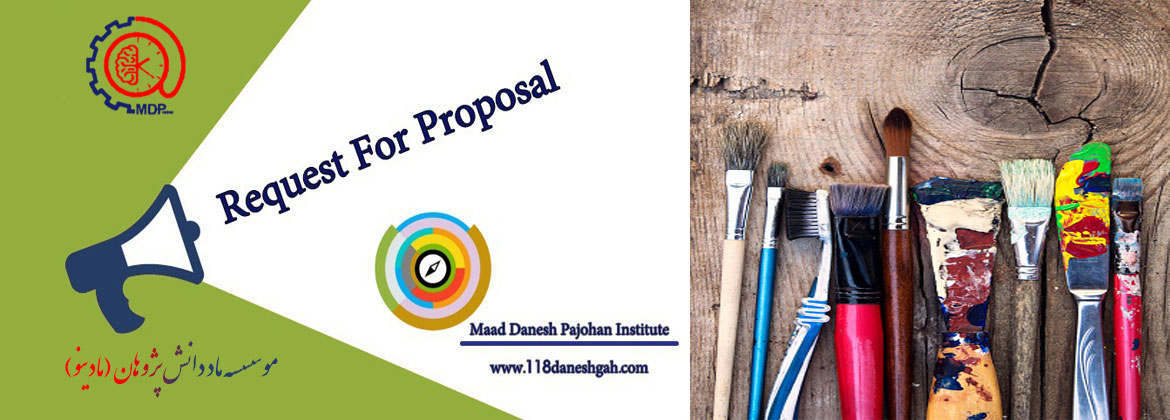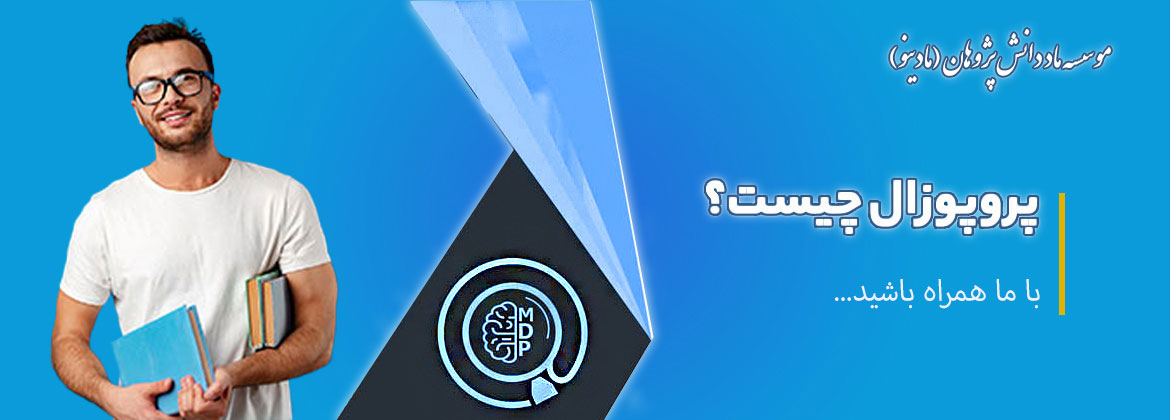- خانه
- ورودوارد حساب کاربری خود شوید و از امکانات ویژه استفاده کنید
- شرح خدماتاز پروپوزال تا مقاله و طرح کسبوکار با پشتیبانی کامل
- ترندهای پژوهشی 2025 | موضوع پایاننامه و مقاله ISIموضوعات نوین پایاننامه و مقالههای ISI در ۲۰۲۵
- بانک جامع موضوعات پایاننامه ارشد و دکتریبانک جامع موضوعات پایاننامه ارشد و دکتری
- نگارش تخصصی پروپوزال کارشناسی ارشد و دکتریبانک جامع نگارش پروپوزال ارشد و دکتری
- مقاله بیس (Base Paper) | مرجع انتخاب موضوع پژوهشی و پایاننامهراهنمای جامع انتخاب و استفاده از مقاله بیس برای تحقیقات دانشگاهی ونگارش پایاننامه
- پیشپروپوزال | راهنمای انتخاب موضوع و نگارش اولیهاز انتخاب موضوع تاتدوین چارچوب تحقیقاتی–راهنمای جامع برای دانشجویان ارشد و دکتری
- پروپوزال موضوعی | انتخاب موضوع پروپوزال ارشد و دکتریانتخاب موضوع مناسب و نگارش پروپوزال حرفهای برای دانشجویان ارشد و دکتری
- پروپوزال دانشگاهینگارش علمی و حرفهای پروپوزال دانشگاهی برای دانشجویان ارشد و دکتری
- پروپوزال صنعتی و تجاریمشاوره و نگارش پروپوزال صنعتی و تجاری برای دانشجویان، پژوهشگران و شرکتها
- برنامه و طرح کسب و کارمشاوره و نگارش برنامه و طرح کسب و کار مطابق استانداردهای جهانی و دانشگاهی
- برنامه تبلیغاتمشاوره و نگارش برنامه تبلیغات با استانداردهای جهانی و کاربردی
- تحقیقات بازارتحلیل علمی و کاربردی بازار برای کسبوکارها، استارتاپها و پژوهشگران
- طرح توجیهیتهیه علمی و کاربردی طرح توجیهی برای کسبوکارها، پروژهها و استارتاپها
- پایاننامه کارشناسی ارشد و رساله دکتری – نگارش تخصصی و علمیبانک جامع نگارش پایاننامه و رساله دکتری
- پلاجریسم و تشابه جوییتشخیص منبعهای مشابه، درصد تشابه و راهکار اصلاح
- سمینار-همایش -کنفرانساز چکیده تا ارائه — پشتیبانی کامل برای شرکت در همایشها و کنفرانسها
- شبیه سازی(آموزش نرم افزار)دورههای عملی و اجرای شبیهسازی مطابق موضوع پایاننامه
- تحلیل آماری(مقاله-پایان نامه...)از طرح پژوهش تا گزارش نهایی — پشتیبانی کامل آماری برای پژوهشگران
- مستند سازی، تالیف و چاپ کتابویراستاری، صفحهآرایی و پیگیری نشر برای پژوهشگران
- نگارش، استخراج و تقویت مقاله علمی – خدمات حرفهای پژوهشیخدمات جامع نگارش و تقویت مقالههای علمی
- سایتیشن علمی مقاله(نمایه استناد)از انتخاب ژورنال تا ثبت استناد — پشتیبانی تخصصی برای پژوهشگران
- نگارش و استخراج مقاله و کتاب مشاوره، نگارش و استخراج مقاله و کتاب با استانداردهای بینالمللی
- سابمیت، پذیرش و چاپ مقالهخدمات سابمیت، پذیرش و چاپ مقاله با رعایت استانداردهای بینالمللی
- ژورنال شناسی و ژورنال یابی پشتیبانی کامل برای ارسال مقاله به ژورنالهای معتبر داخلی و بینالمللی
- ویراستاری و تقویت مقالهاز اصلاح گرامری تا تقویت محتوای علمی — پشتیبانی کامل برای پژوهشگران
- اپلای و پذیرش تحصیلی کارشناسی ارشد و دکتری – راهنمای جامع بینالمللیراهنمای کامل اپلای و پذیرش تحصیلی ارشد و دکتری
- آموزش
- دانشگاه ها و مراکز آموزشی و پژوهشیمعرفی دانشگاهها و مراکز آموزشی و پژوهشی معتبر برای همکاری علمی و پژوهشی
- حسابهای کاربری پژوهشگرانورود، ثبتنام و مدیریت حساب کاربری پژوهشگران برای دسترسی به خدمات اختصاصی
- پایگاه های اطلاعات علمیمعرفی منابع و پایگاههای علمی برای دانشجویان، اساتید و پژوهشگران
- رشته های دانشگاهیمعرفی جامع رشتههای دانشگاهی و فرصتهای پژوهشی مرتبط
- درس نامه های دانشگاهیدسترسی آسان به درسنامههای دانشگاهی و منابع آموزشی معتبر
- اصطلاح شناسی مقاله و ژورنالاصطلاحشناسی و کاربرد اصطلاحات علمی در نگارش مقالات و ژورنالها
- رفرنس نویسی آموزش و خدمات رفرنسنویسی علمی برای دانشجویان و پژوهشگران
- ابزار های پژوهشیابزارها و نرمافزارهای کاربردی برای پژوهشگران و دانشجویان
- اسناد بالادستی ایراندسترسی به اسناد بالادستی، قوانین و سیاستهای کلان ایران برای پژوهشگران
- آزمون های استاندارد جهانی راهنمای آزمونهای تحصیلی و علمی بینالمللی شامل TOEFL, IELTS, GRE و GMAT
- آزمون جی مت (GMAT)راهنمای کامل آزمون GMAT برای دانشجویان و متقاضیان MBA
- آزمون جی آر یی (GRE)راهنمای کامل آزمون GRE برای دانشجویان و پژوهشگران
- آزمون آی مت (IMAT)راهنمای کامل آزمون IMAT برای تحصیل پزشکی و علوم پزشکی
- آزمون آیلتس (IELTS)راهنمای کامل آزمون IELTS برای تحصیل و مهاجرت
- آزمون تافل (TOEFL)راهنمای کامل آزمون TOEFL برای تحصیل و مهاجرت
- آزمون ست (SAT)راهنمای کامل آزمون SAT برای ورود به دانشگاههای بینالمللی
- راهنمای کارآفرینی اینترنتیراهنمای کامل راهاندازی و توسعه کسبوکار آنلاین
- تماس با ماارتباط سریع با کارشناسان موسسه ماد دانشپژوهان
- درباره مامعرفی موسسه ماد دانشپژوهان و خدمات تخصصی پژوهشی
- وبلاگهمراه شما در مسیر پژوهش و نگارش علمی
- فروشگاه118bookshop.ir
- FAQپاسخهای کاربردی به سوالات رایج پژوهشگران و دانشجویان در حوزه علمی و پژوهشی
بیزینس پرو نیوز
کانکت نیوز
اپلای نیوز
سابقه نیوز
پرپوز نیوز
نشر نیوز
تز نیوز
داک نیوز
روز نیوز پیپر
اکانت نیوز
یونی نیوز
ابات نیوز
سایتیشن نیوز
ریسرچ تولز نیوز
ادیت پیپر نیوز
دیتا بیس نیوز
ژورنال نیوز
پیپر نیوز
 راهنمای استخراج مقاله از پایان نامه(ارشد و دکتری)
راهنمای استخراج مقاله از پایان نامه(ارشد و دکتری) استخراج مقاله قواعد استخراج مقاله استخراج مقاله و چاپ کتاب راهنمای فرار از تله های علمی نمونه مقاله های استخراج شده راهنمای نوشتن مقاله علمی: رویکردی گام به گام... ادامه مطلب ..
ترمینو نیوز
آپ نیوز
کاریکلوم نیوز
رفرنس نیوز
استا تست نیوز
اکستراکت نیوز
اخلاق هنر
رشته های دانشگاهی (علوم پزشکی-رزیدنتی)
كليات
- شرايط پذيرش دستيار
- شرايط عمومي
- شرايط اختصاصي
- آزمون پذيرش دستيار
- دورة آموزشي
- شرايط شروع دوره
- شروع دوره
- ترك تحصيلي و انصراف
- انتقال ، جابجايي، تغيير رشته وميهماني
- آموزش دوره دستياري
- مرخصيها
- امور رفاهی
ضوابط عمومي برنامههاي دستياري پزشكی تخصصی
I - مقدمه
الف- عنوان رشتة تخصصي
( كميتة تدوين و ارزشيابي هر رشته براساس شرايط و ويژگيهاي رشتة خود اين قسمت را مشخص ميكند)
ب- تعريف تخصص
(كميتة تدوين و ارزشيابي هر رشته براساس شرايط و ويژگيهاي رشتة خود اين قسمت را مشخص ميكند)
پ- طول دوره آموزش
( كميته تدوين و ارزشيابي هر رشته براساس شرايط و ويژگيهاي رشتة خود اين قسمت را مشخص ميكند)
الف ) عنوان رشته تخصصی
چشم پزشکی
ب – تعریف تخصص
چشم پزشکی یکی از رشته های تخصصی بالینی می باشد که به غربالگری ، پیشگیری ، تشخیص و درمان طبی و جراحی اختلالات چشم و ضمائم آن و راههای بینایی در تمام سنین می پردازد . متخصص این رشته باید قادر به انجام ارزیابی های تشخیصی در مبتلایان به اختلالات چشم و ضمائم آن و راههای بینایی باشد و بتواند در مورد این اختلالات ، اقدامات ، پیشگیری ، درمانی جراحی و غیر جراحی ، توان بخشی و خدمات بینایی ( از جمله عینک و لنز تماسی ) را انجام دهد .
الف – عنوان رشته تخصصي
آسيب شناسي
ب – تعريف تخصص
تخصص آسيبشناسي يكي از رشتههاي تخصصي باليني پزشكي است كه فارغالتحصيلان اين رشته دانش ، بينش و مهارت كافي را در خصوص انجام اقدامات تشخيصي و آزمايشگاهي مناسب و لازم ، بر روي كليه نمونههاي بافتي و غير بافتي اخذ شده از بيماران، از دوران قبل از تولد، طول عمر و پس از از مرگ، و از بررسي ماكروسكوپي تا مولكولي با به كار گيري روشها و ابزار مناسب كسب مينمايند تا با بيان و تفسير علت و چگونگي تغييرات پديد آمده بر اساس وضعيت باليني بيمار ، راهنماييهاي تشخيصي و توصيههاي مناسب را به پزشك مسؤول درمان بيمار ارايه دهند. حيطه كار رشته تخصصي آسيب شناسي شامل اقدامات تشخيصي مختلف بر روي نمونههاي خون ، مايعات، مواد دفعي و بافتهای بدن انسان ، با روشهای آزمايشي مورد تأييد و متداول فيزيكي ، شيميايي، بيوشيميايي، ميكروبيولوژيك، ايمونولوژيك ، سيتوژنيك ، هماتولوژيك پاتولوژی مولكولي، سيتولوژی و هيستوپاتولوژی ميباشد.
هدف رشتة تخصصي آسيبشناسي (پاتولوژي) تربيت پزشكان متخصصي است كه با توجه به تعريف و دامنة كار اين تخصص ( متن ضوابط برنامه دستياري رشتة آسيب شناسي رجوع شود ) تواناييهاي كسب شدة خود را جهت انجام وظيفه به عنوان مسؤولان آزمايشگاهي آسيب شناسي و عضوي موثر از تيم پزشكي براي تشخيص بيماري از طريق كلية جنبههاي مختلف اقدامات آزمايشگاهي در جهت حفظ و ارتقاي سلامت آحاد جامعه به كار گيرند. براي دستيابي به اين امر مهم ، دستياران بايد در طي چهار سال دورة دستياري به تدريج تواناييهاي لازم در حيطة دانش ، بينش و مهارت را با حضور و استفاده مداوم از امكانات آموزشي بخش و آزمايشگاه و پيگيري امور تشخيصي و درماني بيماران كسب نموده، ضمناً در محيط آموزش خود، تحت نظارت هيأت علمي تجربه كنند، به نحوي كه در انتهاي دوره بتوانند به صورت مستقل به حرفه خود اشتغال ورزند. اهداف كلي و بينابيني زير تعيين كننده حدود و حداقل تواناييهاي مورد انتظار از دستياران در پايان دورة آموزشي ايشان ميباشد.
سال آموزشی:
سال اول
اهداف کلی :
1- امکان آشنایی با بیماریهای معمولی در جراحی عمومی فراهم شود .
2- مهارت لازم در تهیه شرح حال و معاینه فیزیکی کسب شود.
3- مهارت های عملی مرتبط باجراحی عمومی کسب شود.
4- مهارت لازم در ارزیابی کلی بیمار جراحی عمومی کسب شود.
5- موارد استفاده از مشاوره و مداخلات جراحی در بیماران مبتلا به درد شکم حاد آموخته شود.
6- اصول مراقبت های قبل از عمل آموخته شود.
مقدمه
متن حاضر، اهداف آموزشي آموزش گيرنده در رشته چشم پزشكي ميباشد. با توجه به وسعت و گستردة وسيع اين رشته و براساس مصوبه كميسيون برنامهريزي و ارزشيابي، در اين متن فقط اهداف كلي و بينابيني بر اساس سال آورده شده و در نظر گرفتن اهداف اختصاصي و جزئيتر به عهده برنامه گذاشته شده است. همچنين بر اساس ضوابط عمومي مصوب شوراي آموزش پزشكي و تخصصي، افزودن اهداف آموزشي اضافي به برنامه دستياري به شرط لطمه نزدن به آموزش دستياران بلامانع است ( بند VI- الف- متن ضوابط).
سال اموزشی : سال اول
اهداف کلی:
1- تجربه لازم در تشخیص و اداره خونریزی واژینال کسب شود .
2- تجربه لازم در تشخیص و اداره عفونت های تناسلی و لگنی کسب شود.
3- اداره تهدید های جنسی آموخته شود
4- میزان اثربخشی روش های جلوگیری و تشخیص حاملگی آموخته شود .
مقدمه
رادیولوژی نوین با توجه به پیشرفت های روزافزون تکنولوژی در علم پزشکی از جایگاه ویژه ای برخوردار است . متخصصین این رشته باید در طی آموزش ، از دانش و مهارت کافی برای پاسخگویی تشخیصی بیماران کلیه رشته های تخصصی برخوردار شده و از این نظر بازور توانایی برای سایر همکاران باشند . تا به این ترتیب در برآوردن نیازهای تشخیصی بیماران توانایی لازم را کسب کنند . علاوه بر آن در مواردی که تکنولوژی در خدمت این رشته قرار می گیرد ، قادر به بکارگیری تکنولوژی باشند . بدیهی است آشنایی با نحوه تجهیز بخش رادیولوژی نیز در دوره دستیاری حاصل خواهد شد . بدین منظور اهداف آموزشی اصلی رشته رادیولوژی به شرح زیر تدوین گردیده است :
سال آموزشی:
سال اول
اهداف کلی :
1-مهارت های لازم برای مجرای هوایی کسب شود.
2- امکان آشنایی با داروهای مورد استفاده در بیهوشی فراهم شود .
3- روش های مونیتورینگ استاندارد آموخته شود.
4- ملاحظات مربوطه به شرح حال و معاینه فیزیکی قبل از عمل آموخته شود.
5-اصول اداره و کنترل درد آموخته شود.
سال آموزشی:
سال اول
اهداف کلی :
1- جوانب کلی مهارت های شرح حال گیری و معاینه فیزیکی برای انجام ارزیابی سیستمیک بیماران مراجعه کننده به دپارتمان اورژانس کسب و تحلیل شود.
2- پاتوفیزیولوژی، تظارهات و اداره بیماری های مربوط به دستگاه گوارش آموخته شود.
3- دانش مربوط به پاتوفیزیولوژی ، تظارهات و اداره بیماری های شایع خونی کسب شود.
4- آگاهی لازم در ورد اجزای سیستم ایمنی و اختلالات مربوط به افزایش یا کاهش عملکرد سیستم ایمنی کسب شود.
5- اختلالات سیستمیک عفونی اصلی، تشخیص و درمان آنها آموخته شود.
6- پاتوفیزویلوژی، ارزیابی و درمان اختلالات کلیوی آموخته شود.
7- آگاهی لازم در مورد علل تظاهرات و درمان اختلالات غدد و متابولیسم کسب شود.
8- آگاهی لازم در مورد اختلالات سیستم تنفسی کسب شود.
سال آموزشی :
سال اول، سال دوم و سال سوم
اهداف کلی :
1- اصول پایه مراقبت از بیماران ترومایی آموخته شود.
2- مهارت در مورد چگونگی ارزیابی، احیا، تثبیت و فراهم نمودن مراقبت دقیق برای بیماران ترومایی کسب شود.
3- استفاده از امکانات تصویری تشخیصی برای ارزیابی بیماران ترومایی آموخته شود.
4- مهارت های پروسیجری مورد نیاز در ارزیابی و اداره بیماران ترومایی کسب شود.
5- تشخیص فوری آسیب های تهدید کننده زندگی و عضو آموخته شود.
6- ملاحظات ویژه در ارزیابی و اداره بیماران ترومایی حامله آموخته شود.
7- ملاحظات ویژه در ارزیابی و اداره کودکان ترومایی آموخته شود.
8- ملاحظات ویژه در ارزیابی و اداره سالمندان ترومایی آموخته شود.
سال اول
جراحی عمومی
انتظار می رود دستیار گوش ، بینی وجراحی سروگردن بعد از پایان چرخش جراحی عمومی برخورد صحیح با بیمار جراحی عمومی ، و ملاحظات قبل وبعد از عمل جراحی را بیاموزد . دستیار باید در پایان این دوره :
1 ـ بتواند از بیمار جراحی شرح حال بگیرد و اورا معاینه کند.
2 ـ بتواند برحسب وضعیت بیمار و نوع جراحی آزمایش های لازم قبل از عمل را درخواست کند.
3 ـ بتواند در مورد بافت نرم مراقبت مناسبی ارایه دهد ( از جمله وسایل مناسب ار انتخاب کند . )
4 ـ عوارض ترمیم زخم و راههای جلوگیری از آنها را بداند .
5 ـ بتواند عفونت های بعد از اعمال جراحی را تشخیص دهد و درمان کند .
6 ـ به طور عملی با گذاشتن چست تیوپ ، کشیدن و عوارض آن آشنایی داشته باشد.
7 ـ بتواند کات داون انجام دهد .
8 ـ بتواند گذاشتن کانتر اداری را انجام دهد .
9 ـ به طور عملی با گذاشتن کانتر سی وی یو cvu آشنایی داشته باشد .
10 ـ بتواند در برخورد با بیمار ترومای متعدد اقدامات اولیه را به طور مناسبی انجام دهد .
الفـ عنوان رشتة تخصصي
گوش، گلو، بيني، و جراحي سر و گردن
بـ تعريف تخصص
رشتة تخصصي گوش، گلو، بيني و جراحي سر و گردن، رشتهاي است كه به اختلالات طبي و جراحي گوش، گلو، بيني، حنجره، و سر و گردن در تمام سنين ميپردازد و شامل ارزيابيهاي تشخيصي و درماني مرتبط با اين رشته در زمينههاي اتولارنگولوژي عمومي، اتولوژي، نورواتولوژي، رينولوژي، آلرژيِ اتولارنگولوژي، برونكوازوفاگولوژي، جراحي سر و گردن، و نيز بخشی از جراحيترميمي و پلاستيك سر و گردن، قاعدة جمجمه، وجراحی فك و صورتاست؛ متخصص اين رشته ميتواند در مورد اين اختلالات اقدامات جراحي و غيرجراحي لازم را، كه شامل توانبخشي و درصورت لزوم ارجاع به پزشكان متخصص ديگر ميشود، انجام دهد.
دستیاران طب اورژانس نسبت به دستیاران داخلی در همان سطح آموزش تخصصی، وظایف و عملکرد یکسانی خواهند داشت . این دستیاران در همان زنجیره نظارتی قرار خواهند گرفت و به دستیاران سال بالاتر داخلی و اساتید آن سرویس گزارش خواهند داد .
نظارت
دستیاران اورژانس تحت نظارت دستیاران سال بالای داخلی و اساتید داخلی هستند.
سال آموزشی:
سال اول ، سال دوم و سال سوم
اهداف کلی :
1- مهارت لازم در برگرفتن شرح حال و انجام معاینه فیزیکی کسب شود
2- دانش لازم در مورد رشد و تکامل و ارزیابی آن کسب شود.
3- دانش لازم در مورد ضروریات ایمن سازی فعلی کسب شود
4- علل، اهمیت و درمان تب و عفونت در کودک آموخته شود.
5- تظاهرات و اهمیت شکایات مربوط به شکم در کودک آموخته شود
6- علل و درمان اورژانس های عصبی در کودک آموخت شود.
7- فیزیولوژی و اداره تغییرات آب و الکترولیت در بچه ها آموخته شود.
8- موارد اختلالات اجتماعی و یا روانپزشکی آموخته شود.
سال آموزشی
سال اول، سال دوم و سال سوم
اهداف کلی :
مهارت درگرفتن شرح حال و انجام معاینه فیزیکی مناسب کسب شود.
اثرات سن، میزان تحصیلات و مسائل اجتماعی – اقتصادی بر روی بیماریها و جراحات ذکر شود
دانش لازم در مورد بیماری های قابل گزارش و فعالیتهای ایمن سازی جاری کسب شود.
علل، تظاهرات و اداره همه جانبه مشکلات بیمار آموخته شود .
انجام پروسیجرهای کوچک و بزرگ مربوط به بخش اورژانس آموخته شود .
توانایی لازم برای برقراری ارتباط با بیماران، خانواده بیماران ، پرسنل حمایت کننده و مشاوران در اورژانس اثبات شود .
فعالیت در یک سیستم پویای ارایه مراقبت های بهداشتی آموخته شود.
پیش پروپوزال
پیش پروپوزال چیست؟ راهنمای جامع برای طرحریزی موفق پروژهها
در دنیای پژوهش و کسبوکار، قبل از شروع هر پروژه بزرگ، نیاز به یک نقشه راه مختصر و دقیق داریم. این نقشه راه، همان پیش پروپوزال (Pre-proposal)است که گاهی با نامهای دیگری چون مقاله سفید (White Paper) یا نامه مقاصد (Letter of Intent - LOI) شناخته میشود.
پیش پروپوزال یک گزارش کوتاه اما کاملاً ساختاریافته است که به یک مشکل مشخص اشاره کرده و راهحلی نوآورانه برای آن ارائه میدهد. هدف از نگارش آن، فراهم کردن اطلاعاتی مختصر و مفید درباره یک مشکل در سازمان یا جامعه و سپس ارائه یک مدل مفهومی برای حل آن است.
در موسسه ماد دانش پژوهان (مادینو)، ما به خوبی میدانیم که یک پیش پروپوزال قوی میتواند اولین قدم برای موفقیت پروژه شما باشد.
برخلاف تصور رایج، یک پیش پروپوزال به دلیل مختصر بودن، نباید کلی و غیرعلمی باشد؛ بلکه محتوای آن باید مبتنی بر منابع علمی، دادههای آماری، مقالات، جداول و نمودارهای تحلیلی باشد. این رویکرد، به طرح شما اعتبار میبخشد و مخاطب را متقاعد میکند.
انواع پیش پروپوزال: از بهبود تا حل مسئله
به طور کلی، دو نوع پیش پروپوزال پرکاربرد در محیطهای صنعتی و آکادمیک وجود دارد که هر یک هدف مشخصی را دنبال میکنند:
1). پیش پروپوزال پیشزمینهای (Backgrounder Pre-proposal) : این نوع پیش پروپوزال که با عنوان "بکگراند" یا "سابقهای" نیز شناخته میشود، به دنبال تقویت و بهبود یک فرآیند موجود در سازمان یا جامعه است. برای مثال، یک سازمان ممکن است به دنبال بهبود فرآیند تولید، افزایش بهرهوری، ارتقاء کیفیت محصولات موجود، تقویت سیستم لجستیک یا ارتقاء روندهای تصمیمگیری فعلی باشد. این نوع پیش پروپوزال، با ارائه شواهد و تحلیلهای دقیق، راههایی برای بهینهسازی و بهبود عملکرد فعلی پیشنهاد میدهد.
2). پیش پروپوزال حل مسئلهای (Problem-solution Pre-proposal) : این نوع پیش پروپوزال، با هدف شناسایی یک مشکل و ارائه راهحل برای آن مطرح میشود. این نوع پیش پروپوزال به دلیل تاثیر مستقیم بر سودآوری و موفقیت، بسیار مورد توجه مدیران سازمانی و صنعتی قرار میگیرد. با شناسایی دقیق یک مشکل و ارائه راهحلی منطقی و قابل اجرا، میتوان تغییرات بزرگی در یک سازمان ایجاد کرد و موفقیت آن را تضمین کرد.
یک نوع دیگر از این اسناد، با عنوان گزارشی (Report) نیز وجود دارد. با این حال، به دلیل عدم تطابق با ماهیت حل مسئلهای در پژوهش، معمولاً نمیتوان آن را یک پیش پروپوزال قلمداد کرد. پیش پروپوزال گزارشی صرفاً به دنبال ارائه آمار و اطلاعات موجود در یک شرکت به مدیران است و هیچ فرآیندی مرتبط با حل یا بهبود یک مسئله را طی نمیکند.
چرا نگارش پیش پروپوزال مهم است؟
اهمیت اصلی نگارش یک پیش پروپوزال در این است که بتواند مدیران یا اساتید شما را نسبت به یک مشکل در جامعه یا سازمان آگاه کرده و یک راهحل منطقی و قابل اجرا برای آن ارائه دهد. یک پیش پروپوزال موفق، در واقع ایده شما را به عنوان یک پژوهشگر یا متخصص، به شکلی قانعکننده و جذاب معرفی میکند.
برای نگارش یک پیش پروپوزال خوب و متقاعدکننده، باید به نکاتی توجه کرد که در مقالات بعدی مادینو به تفصیل به آنها خواهیم پرداخت. با این حال، به خاطر داشته باشید که تمرکز بر روی یک مشکل مشخص، ارائه راهحلی علمی و مستند و استفاده از دادههای معتبر، سه رکن اصلی موفقیت در این فرآیند هستند.
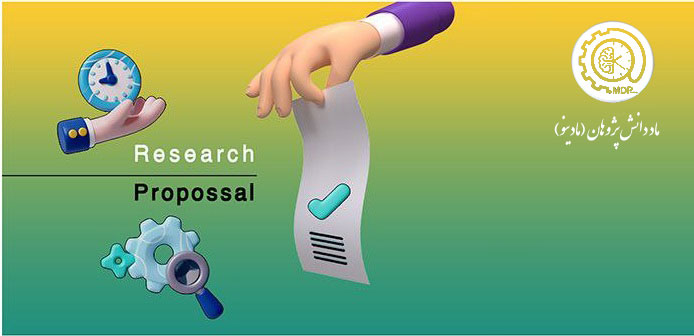
برای نگارش یک پیش پروپوزال خوب و متقاعدکننده، باید به نکاتی توجه کرد که در مقالات بعدی مادینو به تفصیل به آنها خواهیم پرداخت. با این حال، به خاطر داشته باشید که تمرکز بر روی یک مشکل مشخص، ارائه راهحلی علمی و مستند و استفاده از دادههای معتبر، سه رکن اصلی موفقیت در این فرآیند هستند.
نکاتی کلیدی برای نگارش یک پیش پروپوزال متقاعدکننده
همانطور که گفته شد، پیش پروپوزال دروازه ورود به دنیای پروژههای بزرگ است و نگارش یک پیش پروپوزال خوب و متقاعدکننده، نیازمند رعایت نکاتی کلیدی است. در مادینو (ماد دانش پژوهان)، ما این نکات را به صورت کاربردی برای شما گردآوری کردهایم تا بتوانید طرحی حرفهای و بینقص ارائه دهید:
1). عنوان دقیق و جذاب: عنوان پیش پروپوزال شما مانند بیلبورد تبلیغاتی پروژه شماست و نقشی حیاتی در جلب توجه تصمیمگیران، اساتید و مدیران دارد. اگر به ضرورت تحقیق خود ایمان دارید، باید با انتخاب یک عنوان جذاب و تأثیرگذار، اولین قدم را برای متقاعد کردن خواننده بردارید. یک عنوان خوب، به سرعت ماهیت و اهمیت پروژه شما را منتقل میکند.
2). توجیه متقاعدکننده برای ضرورت تحقیق: در بخش مقدمه پیش پروپوزال، باید به طور واضح به مزایا و منافع انجام تحقیق اشاره کنید. با ارائه دادههای آماری معتبر و ذکر مزایای مالی یا اجتماعی حاصل از اجرای تحقیق، میتوانید مخاطب را ترغیب کنید که طرح شما را بپذیرد و بودجه لازم برای پیادهسازی آن را در اختیارتان بگذارد. این بخش باید نشان دهد که چرا اجرای این پروژه، یک سرمایهگذاری ارزشمند است
3). اجتناب از دادههای غلط و اشتباهات نگارشی: وجود هرگونه داده غلط، سرقت علمی (پلاجریسم)، مشکلات نگارشی و غلطهای املایی میتواند دیدگاه مدیران و اساتید را نسبت به پیش پروپوزال شما به شدت منفی کند. دقت و وسواس در نگارش، نشانه تعهد و حرفهای بودن شماست. قبل از ارسال، حتماً متن را به دقت بازبینی کنید.
4). جمعآوری اطلاعات جامع و معتبر: اگر اطلاعات شما در حوزه موضوع تحقیق ضعیف و ناکافی باشد، نمیتوانید تصمیمگیران را به پذیرش پیش پروپوزال خود متقاعد کنید. بنابراین، قبل از شروع به نگارش، سعی کنید کاملترین و صحیحترین اطلاعات را از منابع معتبر و علمی جمعآوری کنید. دانش عمیق شما نسبت به موضوع، نقطه قوت اصلی شما خواهد بود.
5). پیروی از طراحی و ساختار استاندارد: پیش پروپوزالها معمولاً دارای یک ساختار استاندارد و مشخص هستند. در زمان نگارش، باید از این دستورالعملها پیروی کرده و از ارائه اطلاعات ناقص یا ناکافی خودداری کنید. بررسیهای لازم را انجام دهید تا مطمئن شوید تمام بخشهای ضروری، مانند مقدمه، ضرورت تحقیق و متدولوژی، به درستی و به صورت کامل پوشش داده شدهاند. یک طراحی ضعیف میتواند ارزش محتوای عالی شما را نیز تحتالشعاع قرار دهد.
با رعایت این نکات، میتوانید یک پیش پروپوزال قوی و متقاعدکننده بنویسید که راه را برای اجرای پروژه شما هموار میکند.
برای دریافت مشاوره و خدمات نگارش تخصصی پیش پروپوزال، با مادینو تماس بگیرید.
پیش پروپوزال موضوعی - انواع مختلف پروپوزال
پیش پروپوزال سندی مقدماتی است که چارچوب کلی پژوهش را مشخص کرده و مسیر نگارش پروپوزال اصلی را هموار می سازد. پیش پروپوزال با ارائه بیان مسئله و اهداف اولیه، اهمیت موضوع تحقیق را برجسته می کند. این سند نشان می دهد پژوهشگر با ادبیات موجود آشناست و جایگاه پژوهش خود را در میان مطالعات پیشین می داند. روش شناسی پیشنهادی در پیش پروپوزال مسیر گردآوری و تحلیل داده ها را به صورت کلی مشخص می سازد. پیش پروپوزال به عنوان نقشه راه اولیه پژوهش عمل کرده و اعتماد استاد راهنما و کمیته علمی را جلب می کند.
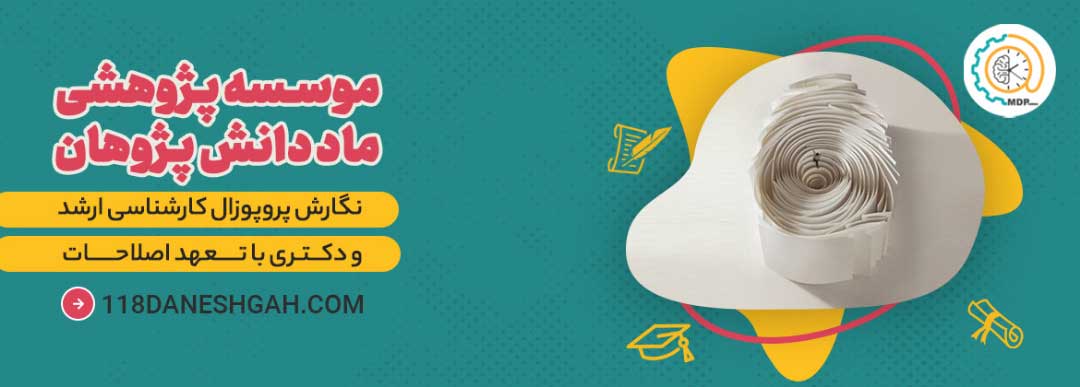
پیش پروپوزال: نخستین گام در مسیر پژوهش های تأثیرگذار
در دنیای پرشتاب پژوهش علمی، گاهی اوقات پیش از ارائه یک پروپوزال کامل و جامع، نیاز به یک معرفی کوتاه و متمرکز است.
اینجاست که مفهوم پیش پروپوزال)Pre-proposal( وارد می شود.
پیش پروپوزال، که با عنوان مقاله سفید )White Paper( یا نامه پروپوزال)Proposal Letter( نیز شناخته می شود، توصیفی مختصر و جذاب از محتوای اصلی پروپوزال شماست.
هدف اصلی از نگارش پیش پروپوزال در مادینو (ماد دانش پژوهان)، علاقه مند کردن مخاطبان (اعم از اساتید راهنما، کمیته های پژوهشی یا حامیان مالی) به محتوای اصلی تحقیقاتی در پروپوزال است. این سند مختصر، یک فرصت عالی برای جلب توجه اولیه و ایجاد یک دیدگاه روشن نسبت به پژوهش شما فراهم می کند.
بسیاری از مؤسسات و شرکت ها برای تسهیل فرآیند بررسی یک پژوهش، پیش از نگارش پروپوزال کامل، از متقاضیان درخواست پیش پروپوزال می کنند؛ چرا که بررسی کلیات، روش تحقیق، کانتریبیوشن (سهم نوآورانه) و تمامی موارد قابل ارائه در تحقیق به صورت مختصر و کارآمد در پیش پروپوزال قابل ارزیابی است.
عناصر کلیدی که باید در پیش پروپوزال خود بگنجانید
چنانچه قصد نگارش پیش پروپوزال را دارید، باید موارد زیر را به صورت مختصر و مفید در آن بگنجانید:
1. مشکلات تحقیق چیست؟
به عنوان یک پژوهشگر، می بایست مشخص کنید که تحقیق شما به دنبال شناسایی چه مشکلی است و چطور قصد دارد آن را برطرف نماید.
به طور کلی، شناسایی مشکل تحقیق یکی از مهم ترین و اصلی ترین فرآیندهای مربوط به نگارش پیش پروپوزال است. این بخش باید به روشنی نشان دهد که پژوهش شما به کدام چالش موجود پاسخ می دهد.
2. هدف تحقیق چیست؟
در این بخش، شما به عنوان پژوهشگر مشخص می کنید که هدف از انجام پژوهش چه چیزی است و چطور قصد دارید با انجام پژوهش به جامعه یا مؤسسه کمک کنید.
هر تحقیقی باید کاربردی بوده و هدفی را دنبال کند، به همین دلیل باید این بخش را به صورت روشن و متمرکز در پیش پروپوزال بیان نمایید.
3. چه اطلاعاتی در مورد عنوان دارید؟
شما باید اطلاعات مختصری را در مورد عنوان پژوهش در پیش پروپوزال بیان نمایید.
البته این اطلاعات همانند ادبیات موضوع در پروپوزال مفصل نیست، اما می توانید خلاصه ای از آن را برای نشان دادن تسلط بر موضوع و پیشینه تحقیق مرتبط ذکر نمایید. این بخش، زمینه کلی پژوهش را برای مخاطب روشن می سازد.
4. به چه طریقی قصد پیاده سازی تحقیق را دارید؟
در این قسمت، خلاصه ای از روش نمونه گیری، ابزارهای تحقیق، روش تجزیه و تحلیل و در مجموع متودولوژی تحقیق را در پیش پروپوزال بیان نمایید. این بخش، نمای کلی از رویکرد شما برای انجام پژوهش را ارائه می دهد و به مخاطب امکان ارزیابی عملی بودن طرح شما را می دهد.
تفاوت پیش پروپوزال و پروپوزال: تمرکز بر ماهیت
همانطور که ملاحظه کردید، پروپوزال و پیش پروپوزال تفاوت فاحشی با هم ندارند و تفاوت اصلی آن ها در حجم محتوا و ماهیت اطلاعاتی است که در آن ها قرار می گیرد.
برای مثال، مباحثی مانند فرضیات، سوالات تحقیق، مدل تحقیق و بسیاری از بخش های اساسی در یک پروپوزال کامل، معمولاً در پیش پروپوزال قرار نمی گیرند. در عوض، مباحثی مانند ضرورت تحقیق، ادبیات موضوع و روش تحقیق به صورت خلاصه و متمرکز قرار می گیرند تا چشم انداز روشنی در مورد پژوهش برای مخاطب فراهم آورند و او را به مطالعه نسخه کامل تر ترغیب کنند.
جمع بندی
پیش پروپوزال به عنوان سند مقدماتی پژوهش، چارچوب کلی تحقیق را مشخص کرده و مسیر نگارش پروپوزال اصلی را هموار می سازد. این سند با ارائه بیان مسئله، اهداف اولیه، مرور منابع و روش شناسی پیشنهادی، نشان می دهد پژوهشگر با ادبیات موجود آشناست و توانایی طراحی یک تحقیق علمی معتبر را دارد. به همین دلیل پیش پروپوزال نقش مهمی در جلب اعتماد استاد راهنما و کمیته علمی ایفا می کند و به عنوان نقشه راه اولیه پژوهش عمل می نماید.
پیش پروپوزال فرصتی برای معرفی مختصر و جذاب ایده پژوهشی است که می تواند توجه مخاطبان، اعم از اساتید، کمیته های پژوهشی یا حامیان مالی را جلب کند. این سند با تمرکز بر ضرورت تحقیق، اهداف کاربردی و روش اجرای کلی، زمینه ارزیابی عملی بودن طرح را فراهم می آورد و مسیر پذیرش پروپوزال کامل را تسهیل می کند. در نتیجه، پیش پروپوزال پلی میان ایده اولیه و اجرای کامل پروژه است و اهمیت آن در موفقیت پژوهش های علمی غیرقابل انکار است.
تحقیقات بازار – پروپوزال استارتاپ – نگارش بیان مسئله در پروپوزال
موسسه پژوهشی ماد دانش پژوهان (مادینو)
پیش پروپوزال یا (pre-proposal) یک سند کوتاه تقریبا دو یا سه صفحه ای است که در آن به یک سری سوالات کلی در مورد پروژه شما پاسخ داده می شود. هدف کلی از ارائه پیش پروپوزال قانع کردن مخاطبین به اجرایی بودن، مقرون به صرفه بودن و بااهمیت بودن پژوهش است. تهیه و آماده سازی پیش پروپوزال با توجه به موضوع، رشته و هدف شخص به سه دسته کلی دانشگاهی (آکادمیک-دانشگاهی)، کسب وکار(صنعتی-تجاری-خدماتی) و عمومی (موضوعی) تقسیم بندی می شود. نگارش پیش پروپوزال بسیار اهمیت دارد چرا که اگر محتوای نگارش شده در آن قابل استناد، قابل توجیه و قابل اجرا نباشند در نهایت پروژه شما مورد تایید قرار نگرفته و رد خواهد شد. موسسه ماد دانش پژوهان تمامی فرآیندهای مربوط به نگارش پیش پروپوزال را با کیفیتی بسیار بالا برای شما دانشجویان، پژوهشگران و صاحبان صنعت انجام خواهد داد.
پیش پروپوزال یک سند کوتاه علمی و تخصصی است که اطلاعات مختصری را در مورد یک پروژه آکادمیک یا تجاری در اختیار مخاطبان قرار میدهد. پیش پروپوزال(Pre-Proposal)، طی سالهای اخیر به یکی از اسناد ضروری برای بسیاری از پروژههای دانشگاهی و صنعتی تبدیل شده است. ضرورت نگارش پیش پروپوزال از این جهت است که شخص با ارائه توضیحاتی مختصر و متقاعدکننده در یک قالب استاندارد بتواند اجرایی بودن یک پروژه را به مخاطبان نشان داده و آنان را برای مطالعه سایر اسناد مرتبط مانند پروپوزال، پایاننامه یا طرح توجیهی ترغیب نماید.
لازم به ذکر است پیش پروپوزال با عنوانهای دیگری مانند مقاله سفید(White Paper) و هدفنامه (LOI یا Letter of Intent)نیز شناخته میشود. بر اساس تعریف ارائه شده توسط دانشگاه استنفورد یک مقاله سفید(White Paper) گزارشی رسمی و تخصصی است که مشکلی را شناسایی کرده و راه حلی قابل انجام برای آن ارائه میدهد. دلیل اختصاص واژه White Paper یا مقاله سفید به مفهوم پیش پروپوزال به این دلیل بوده است که در فرهنگ بروکراسی و دولتی آمریکا، رنگ های مختلف در برخی از فرمها یا سربرگهای دولتی نشاندهنده میزان اهمیت، نوع مخاطب و محتوای درون فرم است و برگه سفید رنگ به معنای محتوای غیرمحرمانه و عمومی است.
برای مثال در فرآیند ویزا و مصاحبه سفارت آمریکا سه فرم با رنگهای مختلف وجود دارد که هر یک مفهوم خاصی را برای فرد مصاحبهشونده و درخواستکننده ویزا آمریکا خواهد داشت. در صورتی که بعد از مصاحبه، شخص درخواستکننده ویزا نتواند مامور سفارتخانه(Officer) را متقاعد کند، یک برگه سفید رنگ از طرف وی دریافت خواهد کرد که نشاندهنده ریجکت شدن پرونده وی خواهد بود. اما اگر یک برگه زرد رنگ از طرف مامور سفارتخانه(Officer) دریافت کند بدین معنا است که احتمال گرفتن ویزا از طرف سفارت 70 درصد خواهد بود و پرونده وی نیاز به بررسی بیشتر دارد و اگر یک برگه صورتی رنگ دریافت کند به معنای این است که احتمال گرفتن ویزا برای شخص درخواست کننده بالای 99 درصد است. بنابراین همانطور که بیان کردیم برخی از مفاهیم فرهنگی در آمریکا در نامگذاری مراحل و فرآیندهای مختلف تاثیرگذار است.
نام دیگری که به مفهوم پیش پروپوزال اختصاص داده شده، هدفنامه(LOI یا Letter of Intent) است که در آن هدف از نگارش شفافسازی یکسری از مفاهیم و دست پیدا کردن به یک توافق مشترک بین دو یا سه نفر یا گروهی از افراد است. بنابراین همانطور که مفاهیم پیش پروپوزال، White Paper و (LOI (Letter of Intent نشان میدهند، دلیل اصلی از ارائه و نگارش پیش پروپوزال، شناسایی یک مشکل خاص و پیشنهاد راه حلی برای برطرف کردن آن است، با تاکید بر این موضوع که بتواند نظر مخاطبان را جلب کرده و توافقی جامع بین نویسنده پیش پروپوزال و مخاطب آن ایجاد کند. برای نگارش پیش پروپوزال استانداردهای مشخصی وجود دارد که در بخشهای مختلف دانشگاهی و تجاری قالبهای استاندارد و مشخصی از طرف سازمان مربوطه برای آن ارائه میشود. به همین منظور در ادامه بخشهای مختلفی که در پیش پروپوزالها مشترک بوده و در تمامی آنها وجود دارد بیشتر صحبت خواهیم کرد تا بتوانیم یک قالب کلی برای نگارش در اختیار مخاطبان عزیز قرار دهیم.
اما پیش از اینکه به بخشبندی یک پیش پروپوزال بپردازیم، باید اصول اولیه نگارش یک پیش پروپوزال استاندارد را بیان کنیم. موضوع اول محدودیت در تعداد صفحات پیش پروپوزال است که حتما باید توسط نگارنده مورد توجه قرار بگیرد. با توجه به اینکه پیش پروپوزال یک سند کوتاه و مختصر در مورد یک موضوع خاص است، باید محتوا و مطالب آن در تعداد محدودی کلمه و صفحه تدوین شود. تعداد صفحات استاندارد برای پیش پروپوزال معمولا 6 صفحه است که یک صفحه به خلاصه موضوع(Synopsis) اختصاص پیدا میکند، 4 صفحه به تشریح ابعاد مختلف موضوع و ارائه راه حل که با عنوان شرح پروژه(Project Description) شناخته میشود و یک صفحه به مباحث مالی و بودجهبندی(Budget Overview) اختصاص داده میشود. یکی دیگر از مواردی که می بایست در زمان نگارش پیش پروپوزال رعایت شود، تعداد کلمات مربوط به هر یک از بخشهای بیان شده است. به طور معمول تعداد کلمات تعیین شده برای بخش خلاصه موضوع(Synopsis) باید در حدود 1000 کلمه باشد و برای بخشهای Project Description و Budget Overview نیز به ترتیب 6000 و 1000 کلمه میزان استاندارد خواهد بود.
پس از رعایت اصول اولیه مربوط به انجام پیش پروپوزال حال نوبت به بخشبندی و ارائه یک فرمت کلی برای ارائه پیش پروپوزال میرسد که در ادامه در مورد بخشهای مختلف آن توضیحات مختصری را ارائه خواهیم کرد.
خلاصه موضوع(Synopsis): در این بخش معمولا خلاصه اجرایی از پروژه بیان شده و در آن ابعاد مختلف مشکل یا موضوع شرح داده میشود. این بخش در فرآیند انجام پیش پروپوزال ترکیبی از مقدمه و ادبیات موضوع را شکل میدهد که در آن مسئله تحقیق بیان شده و ابعاد آن بر اساس کلیدواژههای مشخص شده، تبیین میگردند. همانطور که پیشتر بیان کردیم این بخش از فرآیند نگارش پیش پروپوزال محدودیتهای محتوایی نیز دارد و مفاهیم موجود میبایست در محدوده 1000 کلمهای خلاصه و ارائه شوند. در صورتی که این پروژه با همکاری موسسات و سازمانهای دیگری پیادهسازی میشود، سعی کنید در بخش خلاصه موضوع(Synopsis) معرفی مختصری از این سازمانها و نقش آنها در پروژه را قرار دهید. توجه داشته باشید که این بخش از پیش پروپوزال اولین و مهمترین بخش برای جذب مخاطب و قانع کردن سرمایهگذاران خواهد بود، بنابراین باید محتوای آن را کاملا رسمی, علمی، جذاب و متقاعدکننده نگارش کنید.
شرح پروژه(Project Description): این بخش از پیش پروپوزال کاملترین و اصلیترین بخش از معرفی یک موضوع یا پروژه را به خودش اختصاص میدهد. بدین معنا که شما در بخش قبلی یک مشکل، موضوع یا پروژهای را معرفی کردهاید و حال در قسمت شرح پروژه(Project Description) سعی دارید یک راه حل برای مشکل، یک روش تحقیق برای موضوع یا فرآیند اجرایی برای پروژه معرفی و ارائه نمایید. در این بخش باید مزیتها و دلیل انجام پروژه، نحوه پیادهسازی آن، هدف از اجرای پروژه، سیستم اندازهگیری پیشرفت پروژه (PMS)، روش تحقیق، متخصصان و تیم عملیاتی به دقت تبیین گردند. بسیاری از کارشناسان باور دارند که این بخش از پیش پروپوزال میبایست مبتنی بر خواستهها و نیازهای سرمایهگذاران، مخاطبان و مدیران پروژه نگارش شود، بدین معنا که توجیه اقتصادی و سرمایهای پروژه در این بخش مدنظر قرار بگیرد. در بخش شرح پروژه در فرآیند نگارش پیش پروپوزال معمولا فرضیات و برنامه کاری با زمانبندی دقیق ارائه شده و تیم متخصص، ناظر و عملیاتی پروژه معرفی میشوند. بخش شرح پروژه(Project Description) در پیش پروپوزال دانشگاهی به پیشینه پژوهش و ارائه روش تحقیق قابل اندازهگیری اختصاص مییابد. توجه داشته باشید که در پیش پروپوزال موضوعی و خصوصا تجاری اهداف کوتاه مدت، میان مدت و بلند مدت با برنامه عملیاتی و سیستم اندازهگیری پیشرفت پروژه(PMS) همخوانی داشته باشد. چرا که وجود مغایرت در این بخش از پیش پروپوزال نشان از عدم هماهنگی در پروژه بوده و برای سرمایهگذاران به معنای شکست خواهد بود.
بودجه بندی(Budget Overview): این بخش از نگارش پیش پروپوزال در تصمیم نهایی مخاطب برای پذیرش پروژه و سرمایهگذاری نقش بسزایی خواهد داشت چرا که در نهایت میزان سود حاصل از اجرایی شدن پروژه در مقابل هزینههای عملیاتی آن را ارائه مینماید. در صورتی که اشخاص دیگری در پروژه شما همکاری دارند یک ردیف بودجه جداگانه به آنها اختصاص بدهید و سعی کنید تمام اطلاعات داخل جدول به یک واحد ارزی و یک استاندارد عددی تهیه شده باشند. در زمان نگارش پیش پروپوزال برای هر ردیف بودجه یک توضیح مختصر ارائه کرده و مراحل هزینه کرد آن را تشریح نمایید. در پیش پروپوزال تجاری و صنعتی ممکن است شخص سرمایهگذار تمام هزینههای پروژه را تامین نکند و در این صورت پژوهشگر باید بتواند هزینه نهایی پروژه را محاسبه کرده و سایر منابع مالی در دسترس را نیز در پیش پروپوزال ارائه نماید. لازم به ذکر است که در زمان ارائه جدول بودجهبندی پروژه سعی کنید یک جدول زمانبندی و مرحله برای پروژه ارائه نمایید تا سیستم اندازهگیری پیشرفت پروژه(PMS) را تسهیل کنید.
آزمون ایلتس - آزمون تافل - نگارش پروپوزال - پیش پروپوزال دانشگاهی
شماره تماس: 09102340118 ثبت سریع سفارش ![]()
![]()
پیش پروپوزال موضوعی: کلید ورود به دنیای ایدههای نوین
تصور کنید ایدهای نو در سر دارید، یا برای یک فرصت بینظیر آماده میشوید اما چگونه میتوانید این ایده را به گوش افراد تأثیرگذار برسانید؟
اینجا است که پیش پروپوزال موضوعی وارد میدان میشود. شاید اسمش سند مفهومی (Concept Paper) باشد، یا کاغذ سفید (White Paper)، فرقی نمیکند؛ مهم این است که امروز، این سند در اولویت تصمیمگیری بسیاری از کسبوکارها و سرمایهگذاران قرار دارد. وقتی مدیران، سازمانها یا حتی مخاطبان عمومی با موضوعی جدید روبهرو میشوند، نیاز به اطلاعاتی مختصر و مفید دارند تا بتوانند بهترین تصمیم را بگیرند.
مادینو (ماد دانش پژوهان) اینجاست تا به شما کمک کند این ابزار حیاتی را به بهترین شکل ممکن به کار بگیرید.
چرا پیش پروپوزال موضوعی اینقدر مهم است؟
پیش پروپوزال موضوعی فرصتی بینظیر برای شما فراهم میکند تا اطلاعاتی کاربردی و خلاصهشده را در مورد یک حوزه یا موضوع خاص، که لزوماً جنبهی تجاری یا دانشگاهی ندارد، به مخاطبان خود ارائه دهید.
برخلاف پیش پروپوزالهای دانشگاهی یا تجاری که معمولاً ساختار از پیش تعیینشدهای دارند، تهیهی یک پیش پروپوزال موضوعی نیازمند انعطافپذیری و خلاقیت بیشتری است. چرا؟
چون بخشبندی و فاکتورهای محتوایی آن کاملاً به موضوع مورد بحث، هدف شما و نوع مخاطب بستگی دارد. این آزادی عمل، اگرچه ممکن است چالشبرانگیز به نظر برسد، اما به شما اجازه میدهد پیامتان را به شکلی کاملاً اختصاصی و مؤثر منتقل کنید.
مثل یک مصاحبه شغلی، اما روی کاغذ!
برای اینکه بهتر درک کنید پیش پروپوزال موضوعی چطور کار میکند، یک مصاحبه شغلی را به خاطر بیاورید. فرض کنید شما یک متخصص IT هستید و برای استخدام در یک شرکت معتبر مصاحبه میکنید.
در طول مصاحبه، سوالاتی درباره سابقه کاری، تحصیلات، مهارتها و تسلط شما به نرمافزارها پرسیده میشود. هدف چیست؟
مدیر یا مسئول استخدام میخواهد در مدتزمانی کوتاه، یک تصویر کلی و جامع از تواناییهای شما به دست آورد تا بتواند تصمیم بگیرد که آیا شما برای این موقعیت مناسب هستید یا خیر.
پیش پروپوزال موضوعی دقیقاً همین کار را میکند. این سند، یک دید کلی و شفاف از ایدهی شما به سرمایهگذار یا مدیر موسسه میدهد و ابعاد مختلف موضوع را برای او روشن میسازد. این شانس شماست که در چند صفحه، جوهرهی ایدهی خود را به نمایش بگذارید و مخاطب را متقاعد کنید که این موضوع، ارزش توجه و سرمایهگذاری (زمانی یا مالی) را دارد.
برگ برنده شما: از موفقیت تا شکست!
نوشتن یک پیش پروپوزال موضوعی حرفهای و دقیق، یک مزیت رقابتی قدرتمند برای شما محسوب میشود. این سند میتواند شانس شما را برای پذیرش ایدهتان، چه برای یک پروژه، چه همکاری یا حتی جذب سرمایه، به طرز چشمگیری افزایش دهد اما چه چیزی میتواند باعث رد شدن یک پیش پروپوزال موضوعی شود؟
دلایل مختلفی وجود دارد. گاهی اطلاعات ناکافی یا ناقص است. گاهی محتوا با هدف اصلی شما همخوانی ندارد یا استانداردهای لازم را رعایت نکرده است. و در نهایت، یکی از مهمترین دلایل شکست، عدم جذابیت محتوای ارائه شده است.
یک پیش پروپوزال قوی، تنها ارائهدهنده اطلاعات نیست؛ بلکه باید مخاطب را از همان ابتدا جذب کند و او را به مطالعه و پیگیری بیشتر ترغیب نماید.
ساختار پیش پروپوزال موضوعی
تصور اشتباهی است که پیش پروپوزال موضوعی را صرفاً یک خلاصهی کوتاه از پروپوزال اصلی بدانیم.
هدف حقیقی از نگارش این سند، جذب مخاطب و ترغیب او برای مطالعهی طرح جامعتر است. بنابراین، اولویت نخست در تهیهی یک پیش پروپوزال موضوعی، ایجاد جذابیت و برانگیختن کنجکاوی مخاطب است که نیازمند دانش، مهارت و تجربهای بالا است.
در مادینو (ماد دانش پژوهان)، ما به شما کمک میکنیم تا با رعایت اصول استاندارد، طرحی قانعکننده ارائه دهید.
همانطور که پیشتر اشاره کردیم، محتوا و بخشبندی این نوع پروپوزال میتواند بر اساس هدف، عنوان و مخاطب متفاوت باشد اما برای نگارش یک طرح پیشنهادی قابل قبول، ارائه یک چارچوب استاندارد ضروری است.
در ادامه، به چهار بخش اصلی و مشترک در پیش پروپوزالهای موضوعی میپردازیم.
۱. خلاصه موضوعی (Summary): اولین برداشت، کلید موفقیت
بخش خلاصه موضوعی (Summary) که با عنوان خلاصه اجرایی (Executive Summary) نیز شناخته میشود، اولین، مهمترین و اساسیترین بخش در پیش پروپوزال موضوعی است. این قسمت، در نگاه اول میتواند نظر مخاطب را به خود جلب کند یا او را از ادامه مطالعه منصرف سازد. در این بخش، باید خلاصهای از اهداف اصلی طرح، ماهیت و معرفی موضوع، و سایر مباحث مرتبط را ارائه دهید تا مخاطب ترغیب به بررسی بیشتر پیش پروپوزال شود. اگر این بخش نتواند نظر مخاطبان را جلب کند، به احتمال بسیار زیاد طرح شما رد خواهد شد.
در این بخش، فاکتورهای اجرایی و جذاب موضوع مورد نظر باید به شکلی هوشمندانه مطرح شوند. مواردی نظیر اهداف اصلی پروژه، معرفی و ماهیت پروژه، روش پیادهسازی و اجرای آن، محدودیتهای زمانی، پیشبینی درآمدی (در صورت وجود)، و برنامه کلی پیشبرد آن از جمله مواردی هستند که میتوانید به آنها اشاره کنید. البته، بسته به موضوع انتخابی شما، برخی از این توضیحات ممکن است حذف شده و مباحث جدیدی اضافه شوند. مهم این است که این بخش، تصویری کلی و در عین حال جذاب از پروژهتان ارائه دهد.
۲. اطلاعات سازمانی (Organizational Information): معرفی خود و حامیان پروژه
اهمیت نگارش اطلاعات سازمانی (Organizational Information) در پیش پروپوزال موضوعی بسیار بالاست؛ چرا که کاربرد موضوع مطرح شده و همچنین راهحل ارائه شده را به مخاطب نشان میدهد. این بخش در پیش پروپوزال دانشگاهی معمولاً با عنوان مقدمه (Introduction) و در پیش پروپوزال تجاری و صنعتی با عنوان شرح پروژه (Project Description) شناخته میشود. در این بخش، کاربرد یک پروژه، اهداف اجرایی آن و راهحلهای مستند و قابل اتکا ارائه میگردد. همچنین، در صورت وجود حمایت سازمانی از طرح شما، میتوانید خلاصهای از فعالیتها و پیشینه اجرایی همکاران خود را ارائه دهید.
توجه داشته باشید که محتوای این بخش نباید بیش از حد طولانی باشد و موجب خستگی مخاطب شود.
مواردی که در این بخش ارائه میشوند عبارتند از:
- معرفی سازمان و موسسه حامی پروژه
- خلاصهای از برنامه اجرایی (که در بخش بعدی به صورت تکمیلی بیان میشود)
- مزیتها و نقاط قوت کاری شما نسبت به سایر رقبا
- تبیین موضوع مورد نظر و اهمیت آن در برطرف کردن مشکلات پیش روی سرمایهگذاران
- سابقه اجرایی و موفقیتهای پیشین سازمان برای جذب هرچه بیشتر مخاطبان به طرح پیشنهادی.
در زمان نگارش این بخش، خصوصاً اطلاعات سازمانی، استفاده از تصاویر، جداول، نمودار و اشکال آماری میتواند بسیار مؤثر باشد. اما مراقب باشید!
هرگز سعی نکنید اطلاعات اضافی از کارکنان سازمانی، کارکنان عملیاتی پروژه و مطالب نامرتبط با عنوان مورد نظرتان را در پیش پروپوزال موضوعی بگنجانید. حجم بالای مطالب و وجود مباحث غیرمرتبط میتواند تاثیر منفی بر تصمیم نهایی سرمایهگذار داشته باشد.
۳. برنامه کاری (Work Plan): نقشه راه عملیاتی شما
بخش برنامه کاری (Work Plan) به برنامه عملیاتی و اجرایی شما در پیش پروپوزال موضوعی اشاره دارد که میبایست منطبق بر مشکل بیان شده در بخش قبلی ارائه و تبیین گردد.
معمولاً به این بخش برنامه کار و مسئله (Problem and Work Plan) نیز گفته میشود، زیرا پس از ارائه توضیحاتی دقیق در مورد مشکل موجود و چالشهای پیش روی سرمایهگذاران، اقدام به ارائه برنامهای مدون و قابل اجرا برای حل مشکل میکنیم.
این بخش در پیش پروپوزال موضوعی با عناوینی مانند برنامه عملیاتی (Action Plan) و حوزه کاری (Scope of Work) نیز شناخته میشود. در اینجا، شما باید یک برنامه زمانی و مرحلهای برای پیشبرد پروژه ارائه کرده و جزئیات عملیاتی آن را در هر مرحله بیان کنید.
مطالب موجود در این بخش معمولاً به صورت یک جدول زمانی به همراه جزئیات عملیاتی مربوط به هر بخش و تقسیمبندی مسئولیتی مسئولان اجرایی پروژه ارائه میشود.
به طور کلی، یک برنامه کاری (Work Plan) استاندارد به سوالات زیر پاسخ میدهد:
برای برطرف کردن مشکل، قصد انجام چه کاری را دارید؟
چطور میخواهید پروژه مورد نظرتان را پیادهسازی کنید؟
برنامه زمانی برای پیادهسازی پروژه چگونه خواهد بود؟
هر شخص در این پروژه چه نقشها و مسئولیتهایی را بر عهده دارد؟
و در نهایت، معیار و ابزار برای اندازهگیری پیشرفت پروژه چگونه تعریف شده است؟
همواره به یاد داشته باشید:
کیفیت و کاربردی بودن یک طرح، با برنامه عملیاتی و اجرایی آن سنجیده میشود. اگر در زمان ارائه پیش پروپوزال موضوعی، یک برنامه کاری غیر قابل اجرا و بیکیفیت ارائه کنید، به احتمال زیاد طرح شما با شکست مواجه خواهد شد. بنابراین، توجه داشته باشید که برنامه عملیاتی و اجرایی در پیش پروپوزال موضوعی، تضمینکننده موفقیت یا شکست پروژه شما خواهد بود.
۴. بودجهبندی (Budget): تحلیل مالی و توجیه اقتصادی
جذابترین و تاثیرگذارترین بخش از پیش پروپوزال موضوعی در تصمیمگیری نهایی یک سرمایهگذار، سرفصل مربوط به بودجهبندی (Budget) است. در این بخش، هزینههای انجام پروژه پیشبینی شده و نقش مالی و حمایتی هر شخص یا موسسه به عنوان سرمایهگذار یا همکار در طرح مورد نظر مشخص میشود اما فاکتوری که در پیش پروپوزال موضوعی آن را از سایر طرحهای پیشنهادی متمایز میکند، نوع و قالب ارائه بودجهبندی خواهد بود.
به طور کلی برای تدوین بخش بودجهبندی به صورت کاملاً استاندارد، نیاز است که ۳ فاکتور اصلی را مورد توجه قرار دهیم که هر شخص با توجه به عنوان مورد نظرش میتواند یکی از این فاکتورها را حذف کرده یا فاکتور جدیدی به آن بیافزاید:
تخمین هزینه انجام طرح (Cost Estimation): در این بخش، یک پیشبینی دقیق مبتنی بر اسناد و برنامه عملیاتی در هر فاز به سرمایهگذار ارائه میشود. این تخمین باید واقعبینانه و مستند باشد.
تخمین هزینههای غیرقابل پیشبینی یا برنامهریزینشده (Cost Escalation): معمولاً در بودجهبندی پروژه، یک بازه هزینهای به عنوان هزینههای پیشبینی نشده در نظر گرفته میشود تا در صورت تغییر روند پروژه و افزایش قیمتها، پروژه با مشکل مواجه نشود و کنسل نگردد.
تخصیص بودجه (Cost Assignment): این بخش به وسیله آن، شخص پژوهشگر میتواند بر اساس برنامه زمانی و مرحلهای، هزینه اختصاص یافته به هر فاز عملیاتی را ارائه و تبیین نماید.
سعی کنید هزینهها در بخش بودجهبندی به گونهای ارائه شوند که در مقابل درآمدها و منافع حاصل از عملیاتی شدن پروژه قابل توجیه باشند. این کار، شانس شما را برای پذیرش طرح به میزان قابل توجهی بالاتر میبرد و به سرمایهگذار اطمینان میدهد که سرمایهگذاری او بازدهی مناسبی خواهد داشت.
مادینو (ماد دانش پژوهان) با تخصص خود در نگارش طرحهای پیشنهادی، آماده است تا در تدوین یک پیش پروپوزال موضوعی کامل، جذاب و متقاعدکننده در کنار شما باشد.
آیا آمادهاید تا ایدههایتان را به پروژههای عملی تبدیل کنید؟
نگارش پیش پروپوزال - پروپوزال موضوعی - انواع مختلف پروپوزال
موسسه پژوهشی ماد دانش پژوهان (مادینو)
نگارش پیش پروپوزال دانشگاهی: کلید شروع نگارش پایاننامه و رساله
مسیر نگارش یک پایاننامه ارشد یا رساله دکتری، یک سفر پژوهشی طولانی و پرفراز و نشیب است که میتواند ماهها به طول بینجامد اما پیش از آغاز این سفر، نیازمند یک طرح اولیه و جامع هستید که در اصطلاح به آن پیش پروپوزال گفته میشود.
همانطور که در مقالات پیشین موسسه ماد دانش پژوهان (مادینو) اشاره کردیم، پیش پروپوزال یک طرح پیشنهادی اولیه است که میتواند برای اهداف دانشگاهی، تجاری یا موضوعی ارائه شود.
در این مقاله، تمرکز ما بر پیش پروپوزال دانشگاهی است که نقطه شروعی حیاتی برای هر پژوهشگر در مقاطع تحصیلات تکمیلی محسوب میشود.
چرا پیش پروپوزال دانشگاهی تا این حد اهمیت دارد؟
ارائه پیش پروپوزال دانشگاهی اولین و در عین حال مقدماتیترین مرحله در آغاز نگارش پایاننامه یا رساله دکتری شماست. این سند باید به تایید اساتید راهنما و مشاور برسد و سپس در دفتر تحصیلات تکمیلی دانشگاه ثبت شود.
بسیاری از موسسات آموزشی و دانشگاهها، این فرصت ارزشمند را برای پژوهشگر فراهم میکنند تا با ارائه پیش پروپوزال، نه تنها موضوع مورد نظر و حوزه علاقهمندی خود را به وضوح برای اساتید مشخص کند، بلکه تعهد و جدیت خود را نیز در مسیر پژوهش نشان دهد. این فرآیند، یک غربالگری اولیه است تا اطمینان حاصل شود که موضوع انتخابی شما، دارای پتانسیل لازم برای تبدیل شدن به یک تحقیق جامع و ارزشمند است.
ساختار و حجم: چارچوبی برای بیان ایدهها
نگارش پیش پروپوزال دانشگاهی نسبت به انواع پیش پروپوزالهای موضوعی و تجاری، ساختار مشخصتر و استانداردتری دارد. این ساختار معمولاً توسط خود دانشگاهها در قالب فرمتهای Word و PDF در اختیار دانشجویان قرار میگیرد تا یکپارچگی لازم حفظ شود.
یک پیش پروپوزال دانشگاهی باید در تعداد محدودی کلمه و صفحات معینی نگارش شود؛ معمولاً تعداد صفحات آن بین 3 تا 5 صفحه و تعداد کلمات آن بین 1000 تا 2000 کلمه خواهد بود. این محدودیت، شما را وادار میکند که ایدههای خود را به شکلی موجز، دقیق و سازمانیافته بیان کنید.
پس از ارائه این طرح اولیه، مباحث مختلف آن توسط اساتید مورد ارزیابی دقیق قرار گرفته و در صورت تایید شدن، از پژوهشگر درخواست میشود تا طرح پیشنهادی اصلی یا همان پروپوزال خود را ارائه کند.
دو سوال کلیدی: مسئله و هدف تحقیق
یک پیش پروپوزال دانشگاهی باید به گونهای نگارش شود که بتواند به دو سوال اساسی و بنیادی پاسخ دقیق و شفافی بدهد:
1). مسئله اصلی تحقیق چیست؟
این اولین و مهمترین سوالی است که میبایست در پیش پروپوزال دانشگاهی به آن پاسخ دهید.
شما به عنوان پژوهشگر باید به وضوح مشخص کنید که مشکل شناسایی شده در تحقیق، از اهمیت بالایی برخوردار بوده و پرداختن به آن میتواند ارزش افزودهای برای جامعه علمی و دانشگاهی ایجاد کند.
مسئله تحقیق به طور کلی در دو حالت در پیش پروپوزال دانشگاهی بیان میگردد: یکی، مشکلات موجود در یک شاخه علمی خاص که به درستی شناسایی شده باشند و دیگری، تشخیص مسائل موجود در جامعه که به طور مستقیم بر زندگی افراد تاثیرگذار باشند و نیاز به راهحل علمی داشته باشند.
2). هدف تحقیق چیست؟
دومین سوال مهمی که شما به عنوان نگارنده پیش پروپوزال دانشگاهی باید به آن پاسخ دهید، مربوط به هدف تحقیق است. در این بخش، باید مشخص کنید که چطور و با چه ابزارهایی قصد دارید به بررسی و حل مشکلات مطرح شده در پیش پروپوزال بپردازید. این بخش، نقشه راه شما را برای دستیابی به پاسخ مسئله تحقیق، ترسیم میکند و نشان میدهد که شما برای انجام این پژوهش، برنامهریزی دقیق و روشنی دارید.
ساختار استاندارد پیش پروپوزال
در ادامه، برای آشنایی بیشتر دانشجویان با مفاهیم و مبانی ارائه پیش پروپوزال دانشگاهی، موسسه ماد دانش پژوهان (مادینو) سعی میکند یک ساختار سازمانیافته و استاندارد برای نگارش آن ارائه کند. این ساختار به شما کمک میکند تا ایدههای خود را به بهترین شکل ممکن، مطابق با انتظارات دانشگاهها و اساتید، سازماندهی و ارائه دهید. با همراهی مادینو، نگارش پیش پروپوزال نه تنها سادهتر، بلکه به تجربهای موفقیتآمیز تبدیل خواهد شد.
نگارش یک پیش پروپوزال دانشگاهی، اولین گام و شاید بتوان گفت یکی از مهمترین مراحل در شروع نگارش پایاننامه ارشد یا رساله دکتری است. این سند اولیه، پلی ارتباطی بین ایده پژوهشی شما و اساتید راهنما و مشاور است.
در موسسه ماد دانش پژوهان (مادینو)، ما اهمیت هر بخش از این سند را درک میکنیم و در این مقاله، به توضیح جزئیات و نکات کلیدی بخشهای اصلی پیش پروپوزال دانشگاهی میپردازیم تا شما را در مسیر نگارش یک طرح پیشنهادی قوی یاری رسانیم.
خلاصه تحقیق (Executive Summary)
بخش خلاصه تحقیق (Executive Summary)، درست مانند مقدمه در پایاننامه یا پروپوزال، اولین تصویری است که مخاطب از طرح پیشنهادی شما دریافت میکند.
هدف اصلی این بخش، ارائه یک دید کلی و جامع از محتوای پیش پروپوزال به اساتید راهنما و مشاور است. در این قسمت باید به اختصار، اهمیت موضوع، پیشینه پژوهشی مرتبط، دلیل انجام تحقیق و کاربردهای احتمالی آن را بیان کنید.
در Executive Summary، میتوانید کلیدواژههای اصلی تحقیق را به صورت مختصر تعریف کرده و اهمیت تحقیق را برای مخاطب تشریح کنید. این بخش باید قابلیت این را داشته باشد که یک راهحل اولیه برای مشکل شناساییشده را نشان دهد و علاقه و توانایی شما را در حل مسائل پژوهشی به نمایش بگذارد. حجم این بخش معمولاً محدود است و میبایست حداکثر ۱۰درصد کل متن پیش پروپوزال، یا حداکثر ۵۰۰کلمه را تشکیل دهد.
همانطور که دانشگاه تگزاس ای اند ام (Texas A&M University) نیز تاکید میکند، یک خلاصه اجرایی موفق میتواند تعاملی مقدماتی و مثبت بین پژوهشگر و مخاطب ایجاد کند که منجر به جلب نظر و تایید طرح پیشنهادی شما خواهد شد.
مشکل پژوهش (Problem Statement)
بخش مشکل پژوهش (Problem Statement)جایی است که شما باید توضیحی جامع و کامل از مشکل تحقیق را برای مخاطب بیان کرده و ابعاد موضوع را با دقت تبیین کنید. در این قسمت، نگارنده باید به صورت قانعکنندهای مسئله تحقیق را توضیح دهد و اهمیت و کاربرد آن را برای جامعه مشخص نماید. برخلاف Executive Summary که یک خلاصه کلی از تمام بخشها ارائه میدهد، در Problem Statement، توضیح مسئله تحقیق با جزئیات بیشتر و عمیقتر خواهد بود.
یکی از سریعترین و مناسبترین روشها برای تبیین و تشریح مسئله تحقیق، استفاده از استراتژی ۵W است.
این استراتژی بر پنج فاکتور اصلی تاکید دارد که به شما کمک میکند تا مسئله خود را از زوایای مختلف بررسی کنید:
- چه کسی: مسئله تحقیق شناسایی شده بر زندگی چه افراد و چه کسانی تاثیرگذار است و ارائه راهحل چگونه میتواند به این افراد کمک کند؟ شناسایی ذینفعان اصلی، گام اول است.
- چه چیزی: دقیقاً ماهیت و هویت مسئله چیست؟ چطور این مشکل در جامعه یا در یک شاخه علمی شناسایی شده است؟ باید به ماهیت اصلی مشکل بپردازید.
- چه زمانی: مشکل شناسایی شده چه زمانها و در چه شرایطی رخ میدهد؟ شما باید مخاطب خود را قانع کنید که این مشکل یک مسئله اساسی است که به کرات رخ میدهد و زندگی افراد را تحت تاثیر قرار میدهد.
- کجا: موقعیت دقیق برای رخ دادن این مشکل کجاست؟ پاسخ دقیق به این سوال معمولاً سمت و سوی تحقیق را مشخص کرده و حوزه اصلی کار تحقیقاتی (مانند گردآوری دادهها یا توزیع پرسشنامه) را تعیین میکند.
- چرایی: اهمیت این مشکل برای جامعه یا یک شاخه علمی چقدر بالاست؟ چرا برطرف کردن این مشکل ضرورت دارد؟ در این بخش، باید دلایل اهمیت و فوریت تحقیق خود را بیان کنید.
ادبیات موضوع مقدماتی (Preliminary Literature Review)
برای اینکه پژوهش شما از سندیت بالایی برخوردار بوده و اعتبار علمی و تحقیقاتی قابل قبولی داشته باشد، باید توضیحات مختصری از پیشینه تحقیق را بیان کنید. در بخش ادبیات موضوع مقدماتی (Preliminary Literature Review)، سعی کنید کلیدواژههای تحقیق خود را به درستی شناسایی کرده و تحقیقات انجامشده و بهروز را استخراج کنید. سپس، مواردی که میتوانند مرتبط با مسئله تحقیق شما باشند را در این بخش بگنجانید.
ادبیات موضوع در این قسمت باید نشان دهد که چه تحقیقاتی در حوزه مرتبط با موضوع انتخابی شما انجام گرفته و چه نتایجی را در بر داشته است.
مهمتر از آن، باید مشخص کنید که تحقیق شما چگونه میتواند تحقیقات پیشین را تکمیلتر کند یا شکافهای موجود در دانش را پر نماید. این بخش، به اساتید نشان میدهد که شما از وضعیت فعلی دانش در حوزه خود مطلع هستید و به دنبال افزودن ارزشی جدید به آن هستید.
روش تحقیق (Methodology)
آخرین و در عین حال مهمترین بخش پیش پروپوزال دانشگاهی، نگارش روش تحقیق (Methodology)است. در این بخش، شما باید مخاطب را متقاعد کنید که روش مناسب و موثری برای ارزیابی مشکل شناسایی کردهاید و قصد دارید یک راهحل کاملاً علمی و قابل اتکا ارائه دهید. برای نگارش صحیح این بخش، میبایست ابزارها و روشهای جمعآوری داده و اندازهگیری قابل قبولی داشته باشید.
در این بخش از پیش پروپوزال، شما به صورت مختصر مشخص میکنید که جامعه آماری تحقیق چه کسانی هستند و چطور قصد دارید یک نمونه آزمایشی از میان آنها انتخاب کنید. در مرحله بعد، میتوانید ابزار گردآوری دادهها (مانند پرسشنامه، مصاحبه، یا تحلیل اسناد) را مشخص کرده و روش تحلیل (مانند تحلیل آماری، تحلیل کیفی، یا روشهای ترکیبی) را انتخاب کنید. توجه داشته باشید که تمامی این موارد میبایست مبتنی بر سوالات، فرضیات و مسئله تحقیق شما باشد. یک روش تحقیق قوی، نشاندهنده بینش شما و امکانپذیری پروژه شماست.
موسسه ماد دانش پژوهان (مادینو) با تیمی از متخصصان مجرب، آماده یاری رساندن به شما در تمامی مراحل نگارش پیش پروپوزال و پروپوزال دانشگاهی است.
آیا برای شروع این گام مهم آمادهاید؟
پیش پروپوزال صنعتی و تجاری:
پلی میان پژوهش و دنیای کسب و کار
نگارش پیشپروپوزال، فارغ از نوع آن، ممکن است برای بسیاری از پژوهشگران استرسزا به نظر برسد، اما وقتی صحبت از پیشپروپوزال صنعتی و تجاری به میان میآید، علاوه بر جذابیت و متقاعدکننده بودن برای مخاطب، محتوای آن باید به گونهای نگارش شود که کاملاً کاربردی و قابل پیادهسازی باشد.
در مادینو (ماد دانش پژوهان)، ما به شما کمک میکنیم تا این چالش را به فرصتی برای اثبات ارزش پژوهش خود تبدیل کنید.
چرا پیش پروپوزال صنعتی و تجاری اهمیت دارد؟
زیرا این نوع پیشپروپوزالها با هدف توسعه و بهبود یک واحد تولیدی یا کسب و کار نگارش میشوند.
این اسناد، که گاهی به آنها پیش پروپوزال تکنیکال (Technical Pre-proposal)، بیانیه کاری (Statement of Work)، یا پیش پروپوزال پروژهای (Project Pre-proposal) نیز گفته میشود، با اهدافی مانند معرفی یک محصول خاص، ارائه یک راهحل فنی برای یک کسب و کار، یا ایجاد ارتباط سازمانی میان دو صنعت مختلف شکل گرفته و طراحی میشوند.
شناسایی مشکل: گام نخست و حیاتی
زمانی که یک پژوهشگر اقدام به نگارش پیش پروپوزال تجاری یا صنعتی میکند، در گام نخست میبایست مشکل پیش روی کسب و کار را به درستی شناسایی کند. این مرحله، که مهمترین بخش است، نیازمند بینش عمیق و رویکردی تحلیلی است.
در بسیاری از مواقع، یک صنعت دچار مشکل در حوزههایی مانند فروش، تولید، بازاریابی، یا بهرهوری میشود که در نهایت به صورت مستقیم سودآوری شرکت را تحت تأثیر قرار خواهد داد. در این مرحله، نیاز است که یک پژوهشگر متخصص با رویکردی خلاقانه و تحلیلگر وارد کسب و کار شده و برای مشکل پیش رو یک راهحل دقیق و کاربردی ارائه دهد.
به همین دلیل، همواره تأکید میشود که در پیش پروپوزال صنعتی و تجاری، شخص نگارنده باید در وهله اول مشکل پیش روی واحد تولیدی را به درستی شناسایی کند و در نهایت برای حل آن مشکل راه حل ارائه نماید.
در این مسیر، ایجاد جذابیت محتوایی در پیش پروپوزال در اولویت سوم و پایانی، بعد از شناسایی مشکل و ارائه راهحل، قرار خواهد گرفت.
رویکرد مادینو برای نگارش پیش پروپوزال صنعتی و تجاری
در مادینو، ما بر این باوریم که یک پیش پروپوزال صنعتی و تجاری موفق، باید توانایی تبدیل چالشهای یک کسب و کار به فرصتهای رشد و توسعه را داشته باشد.
ما به شما کمک میکنیم تا:
- مشکل را دقیقاً تعریف کنید: با پژوهش و تحلیل عمیق، ریشه مشکلات موجود را شناسایی و به وضوح بیان کنید.
- راهحلهای کاربردی ارائه دهید: راهحلهایی را پیشنهاد دهید که نه تنها خلاقانه باشند، بلکه از نظر فنی و اجرایی، واقعبینانه و قابل پیادهسازی باشند.
- مزایای راهحل را برجسته کنید: نشان دهید که چگونه راهحل پیشنهادی شما به بهبود سودآوری، کارایی، یا موقعیت رقابتی کسب و کار کمک میکند.
- ساختار حرفهای را رعایت کنید: از اصطلاحات فنی مناسب استفاده کرده و محتوای خود را به شیوهای منطقی و متقاعدکننده سازماندهی کنید.
با همکاری با مادینو، میتوانید اطمینان حاصل کنید که پیش پروپوزال صنعتی و تجاری شما نه تنها از نظر علمی معتبر است، بلکه به طور مؤثری نیازهای دنیای کسب و کار را برآورده میکند.
آمادهسازی پیش پروپوزال صنعتی و تجاری: رویکرد مادینو
در دنیای کسبوکار امروز، یک پیش پروپوزال صنعتی و تجاری موفق، فراتر از یک سند ساده است؛ این یک ابزار استراتژیک برای جلب اعتماد و سرمایه است.
در مادینو (ماد دانش پژوهان)، ما با درک ابعاد و اهداف مختلف، سه رویکرد اصلی را برای آمادهسازی یک پیش پروپوزال تأثیرگذار به شما پیشنهاد میدهیم:
وضوح اهداف: ابتدا، هدف از نگارش پیش پروپوزال را مشخص کرده و بصورت دقیق تعیین کنید که قصد انجام چه کارهایی را دارید. این وضوح، نقطه شروع هر پروژه موفق است.
برنامهریزی قانعکننده: برنامه کاری، زمانبندی و بودجهبندی پروژه را کاملاً قانعکننده و قابل اجرا تدوین نمایید. یک برنامه واقعبینانه، نشاندهنده حرفهایگری و جدیت شماست.
تبیین اهمیت اجرایی: دلیل و اهمیت اجرایی شدن و پیادهسازی پیش پروپوزال را تبیین کنید. چرا این پروژه باید انجام شود و چه ارزشی برای مخاطب یا سازمان ایجاد میکند؟
ویژگیهای ساختاری یک پیش پروپوزال تجاری با کیفیت
اگر بخواهیم ویژگیهای ساختاری یک پیش پروپوزال تجاری خوب و با کیفیت را تعریف کنیم، یکی از آنها قطعاً ظاهر و ساختار حرفهای است که اصطلاحاً به آن "Look Professional" میگویند.
بدین معنا که هر پیش پروپوزالی اعم از دانشگاهی، تجاری یا موضوعی میبایست در یک قالب استاندارد آماده شود. از طرف دیگر، یک پیش پروپوزال ایدهآل میبایست از نظر فنی بسیار قوی باشد تا بتواند نظر مخاطبان را به خود جلب کند.
به طور کلی، یک پیش پروپوزال تجاری و صنعتی در حالت استاندارد دارای بخشهای زیر خواهد بود:
1. خلاصه اجرایی (Executive Summary)
این بخش، یک محتوای مختصر در مورد ماهیت پروژه، اهداف و چرایی انجام پروژه است که یک دید کلی از پیش پروپوزال به مخاطب میدهد. در این قسمت میتوانید بر رویکردهای مدیریتی و فنی پروژه به صورت خلاصه تأکید کرده و یک سری اطلاعات کلی در مورد نوع محصول، راهحل یا زمینه ارتباطی که قصد دارید با سازمان مورد نظر ایجاد کنید، ارائه نمایید.
نکات مهم:
محتوای این بخش حداکثر یک صفحه از پیش پروپوزال صنعتی و تجاری را دربرمیگیرد و تعداد کلمات آن میتواند بین 500 تا 1000 کلمه متغیر باشد.
در این بخش معمولاً دو موضوع تخصصی به نامهای مشکل تحقیق (Statement of Problem) و هدف پروژه (Objective) را مورد بررسی قرار خواهید داد.
2. مشکل تحقیق (Statement of Problem)
در بخش مشکل تحقیق در پیش پروپوزال تجاری، یک توضیح مختصر در مورد سازمان و اهمیت پروژه داده میشود. پیش از اینکه اهمیت پروژه را برای سرمایهگذار یا مخاطب بیان کنید، میبایست سازمان و مؤسسه خود را به درستی معرفی کنید.
نکات مهم:
در زمان معرفی سازمان سعی کنید نکاتی را بیان کنید که نشاندهنده سابقه و تخصص شما است و میتواند مخاطب را قانع کند که شما و تیم سازمانیتان قابلیتهای لازم برای حل مشکل را دارید.
بعد از اینکه مخاطب را در مورد قابلیتهای خودتان متقاعد کردید، باید سعی کنید که مشکل پیش روی سازمان را به درستی معرفی کرده و برنامه قابل قبولی برای آن ارائه نمایید. این شفافیت در شناسایی مشکل، پایه و اساس ارائه راهحل مؤثر است.
3. اهداف (Objective)
در بخش اهداف، باید محصولات، خدمات و یا نیازهای مشتریان و بازار مورد نظرتان را معرفی کرده و بگویید چگونه این ویژگیها میتوانند مشکل شناسایی شده را برطرف کنند. این بخش باید به وضوح نشان دهد که پروژه شما چه نتایج ملموسی را به ارمغان خواهد آورد.
رویکرد فنی در پیش پروپوزال صنعتی و تجاری: ارائه راهحلهای مؤثر
در نگارش پیش پروپوزال صنعتی و تجاری، بسیاری از پژوهشگران گمان میکنند که باید تمام جزئیات راهحل را ارائه کرده و مشکل را به طور کامل برطرف کنند. البته این موضوع صحت دارد که راهحل یک موضوع هرچه جامعتر و دقیقتر تدوین شود، میتواند نتیجه مطلوبتری در پی داشته باشد؛ اما لزومی ندارد که در مرحله اول در پیش پروپوزال تجاری و صنعتی تمامی ابعاد و جنبهها را شناسایی کرده، مشکلات را برطرف نموده و استراتژیهای نوینی برای هر مشکل در آینده ارائه نمایید.
بهترین استراتژی در نگارش پیش پروپوزال تجاری و صنعتی این است که یک راهحل تخصصی برای برطرف کردن مشکل در اولین مرحله ارائه شود. در بخش رویکرد فنی (Technical Approach)، یک برنامه تخصصی با توجه به مسائل شناسایی شده به مخاطب ارائه میگردد. این برنامه ممکن است شامل فرایند معرفی یک محصول جدید، ارائه یک خدمت منحصر به فرد، فعالیت در یک بازار جدید، سرمایهگذاری بر روی مشتریان جدید و یا ایجاد یک ارتباط سازمانی باشد.
در مادینو (ماد دانش پژوهان)، ما به شما کمک میکنیم تا این بخش را به مؤثرترین شکل ممکن تدوین کنید.
در این بخش معمولاً باید توضیحات جامعی را در مورد سوالات مطرح شده زیر ارائه نمایید:
چه فرآیندهایی برای ارائه راهحل طی شده است و آیا این راهحل قابل اتکا خواهد بود؟
برای اینکه بتوانید به این سوال پاسخ دقیق بدهید، باید در مرحله اول مشکلات را به درستی شناسایی کرده باشید و در مرحله بعد برنامهای قابل اجرا مبتنی بر مستندات موجود ارائه نمایید. این نشاندهنده دقت و جدیت شما در پژوهش است.
چرا باید این رویکرد فنی را انتخاب کرد و چه مزیتی برای کسب و کار دارد؟
برای پاسخ به این سوال باید مزایا و نقاط قوت پروژهتان را بیان نموده و مزیت رقابتی پروژهتان را نسبت به سایرین برای مخاطبان تبیین کنید. این بخش به سرمایهگذار یا سازمان نشان میدهد که چرا راهحل شما بهترین گزینه است.
روش ارزیابی و پیشرفت عملکرد چگونه است؟
برای اینکه بتوانید به این سوال پاسخ دهید، باید در مرحله اول برنامه، زمانبندی عملیاتی و تقسیم وظایف را مشخص کنید و در مرحله دوم با توجه به جدول زمانبندی، یک ابزار ارزیابی عملکرد برای پیشرفت پروژه ارائه نمایید. این شفافیت در اندازهگیری پیشرفت، اعتماد مخاطب را جلب میکند.
گزینههای جایگزین (پلن B) در صورت ناموفق بودن راهحل اصلی چه خواهد بود؟
این سوال آخر در زمان نگارش پیش پروپوزال صنعتی و تجاری بسیار مهم است. توصیه میشود حتماً یک پلن جایگزین (پلن B)، حتی با توضیحات مختصر، در پیش پروپوزال در بخش رویکرد فنی در نظر داشته باشید. این موضوع نشاندهنده دوراندیشی و توانایی شما در مدیریت ریسک است.
بودجهبندی (Budget): تخمینی دقیق و واقعبینانه
بخش بودجهبندی یکی از حساسترین و مهمترین قسمتهای پیش پروپوزال صنعتی و تجاری است. در این بخش، میبایست یک تخمین دقیق در مورد هزینههای پروژه انجام دهید.
برای اینکه بتوانید بودجهبندی پروژه خودتان را با حاشیه امنیت بیشتری در نظر داشته و در طی پیادهسازی پروژه با کمبود بودجه مواجه نشوید، باید به نکات زیر توجه کنید:
ارزیابی دقیق هزینهها با حاشیه خطا: تا جایی که امکان دارد هزینههای پروژه را دقیق ارزیابی کنید، اما برای اینکه بتوانید از بودجه خود مطمئن باشید، سعی کنید که مبلغ پیشنهادی در پیش پروپوزال را اندکی بالاتر در نظر بگیرید.
برای هر بخش از بودجهبندی، معادل 10-20% خطای محاسباتی لحاظ نمایید. این کار شما را در برابر نوسانات و هزینههای پیشبینی نشده محافظت میکند.
آگاهی از سقف بودجه سازمان: سعی کنید پیش از ارائه بودجهبندی پروژه، از میزان هزینه کرد سازمان آگاهی حاصل کنید.
برای مثال، در صورتی که بودجه لازم برای اجرای پروژه شما 20 میلیارد تومان باشد و حداکثر مبلغ قابل اختصاص از طرف شرکت برای اجرای پروژه 10 میلیارد تومان باشد، در نهایت پروژه شما نمیتواند نظر سرمایهگذاران را جلب کند و رد خواهد شد.
جزئیات تخصیص بودجه: نحوه تخصیص بودجه به پروژه مورد نظرتان را به دقت تعیین کنید. بدین معنا که باید نحوه و نوع تخصیص بودجه را با جزئیات بسیار بالا و زمانبندی دقیق ارائه نمایید که برای مخاطبان و سرمایهگذاران ملموس و قابل اندازهگیری باشد. شفافیت در این بخش، اعتماد سرمایهگذار را جلب میکند.
در مادینو (ماد دانش پژوهان)، ما با تخصص خود در زمینه نگارش پیش پروپوزال صنعتی و تجاری، به شما کمک میکنیم تا یک رویکرد فنی قدرتمند و یک بودجهبندی واقعبینانه و متقاعدکننده ارائه دهید.
آیا آمادهاید تا پروژه خود را به مرحله اجرا برسانید؟ با ما تماس بگیرید.
پژوهش موضوعی – فیشنویسی در تحقیق – طراحی مدل در پایان نامه و رساله
موسسه پژوهشی ماد دانش پژوهان (مادینو)
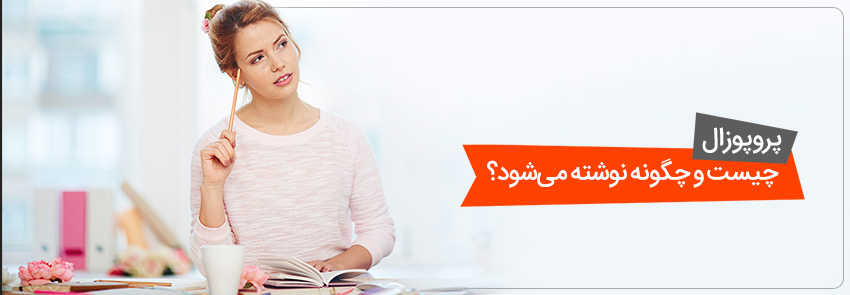
پیشپروپوزال: کلید طلایی گشایش درهای پژوهش و جلب حمایتهای علمی
در مسیر پرچالش تحقیقات علمی، جایی که ایدههای نوپا به دنبال فرصت شکوفایی هستند، پیشپروپوزال نقشی حیاتی و استراتژیک ایفا میکند. این سند مختصر، که با نامهای مقاله سفید (White Paper) یا نامه پروپوزال (Proposal Letter) نیز شناخته میشود، نه یک خلاصهنویسی ساده، بلکه ویترینی هوشمندانه از محتوای اصلی پروپوزال شماست.
هدف اصلی از نگارش پیشپروپوزال، جلب نظر و علاقهمند کردن مخاطبان کلیدی به عمق تحقیقات پیشنهادی شماست؛ این مخاطبان میتوانند داوران، مدیران ارشد موسسات، یا حامیان مالی بالقوه باشند.
موسسه ماد دانش پژوهان (مادینو) با تجربه دیرینه و دانش تخصصی خود در نگارش پروپوزال و پیشپروپوزال، به شما کمک میکند تا این سند را به ابزاری قدرتمند برای موفقیت پژوهشی خود تبدیل کنید.
چرا پیشپروپوزال؟
معمولاً سرفصلهای موجود در پروپوزال به صورت کاملاً مختصر و متمرکز بر موضوع تحقیق در پیشپروپوزال ارائه میشوند. این تمرکز، به مخاطبان امکان میدهد تا در کوتاهترین زمان ممکن، به ماهیت پژوهش شما پی ببرند و در صورت علاقهمند شدن به محتوا، زمینه برای ارائه محتوای تکمیلیتر و تفصیلیتر (همان پروپوزال اصلی) فراهم شود.
بسیاری از موسسات یا شرکتهای حمایتکننده پژوهشی، برای تسهیل فرآیند بررسی یک پژوهش و جریاندهی کارآمد ارزیابیها، ترجیح میدهند قبل از صرف زمان بر روی مطالعه یک پروپوزال جامع و مفصل، از متقاضیان درخواست پیشپروپوزال کنند. این رویکرد هوشمندانه، امکان بررسی کلیات، روش تحقیق، نوآوری و مشارکت (کانتریبیوشن) و تمامی موارد قابل ارائه در تحقیق را به صورت مختصر و قابل ارزیابی در پیشپروپوزال فراهم میآورد.
مادینو با اشراف کامل بر معماری پیشپروپوزالهای موفق، به شما یاری میرساند تا سندی تهیه کنید که دقیقاً با نیازهای این موسسات همسو باشد و پتانسیل پژوهش شما را در همان نگاه اول نمایان سازد.

چهار رکن اصلی یک پیشپروپوزال تأثیرگذار
چنانچه قصد نگارش پیشپروپوزال را دارید، گنجاندن چهار عنصر زیر در آن حیاتی است:
- مشکل تحقیق چیست؟شناسایی قلب پژوهش:
به عنوان یک پژوهشگر، شما میبایست به وضوح مشخص کنید که تحقیق شما به دنبال شناسایی چه مشکلی است و چگونه قصد دارد آن را برطرف نماید.
به طور کلی، شناسایی دقیق و روشن مشکل تحقیق یکی از مهمترین و اصلیترین فرآیندهای مربوط به نگارش پیشپروپوزال است؛ زیرا این بخش، دلیل وجودی پژوهش شما را توجیه میکند.
- هدف تحقیق چیست؟تبیین گامهای کاربردی و تأثیر اجتماعی:
شما به عنوان پژوهشگر، باید به روشنی مشخص کنید که هدف از انجام پژوهش چه چیزی است و چگونه قصد دارید با انجام پژوهش به جامعه یا موسسه کمک کنید.
هر تحقیقی باید کاربردی بوده و هدفی مشخص را دنبال کند؛ به همین دلیل، باید این بخش را به صورت متقاعدکننده در پیشپروپوزال بیان نمایید تا ارزش افزودهای که پژوهش شما ایجاد خواهد کرد، برجسته شود.
- چه اطلاعاتی در مورد عنوان دارید؟نمایی مختصر از بستر دانش:
شما باید اطلاعات مختصری را در مورد عنوان پژوهش و بستر آن در پیشپروپوزال بیان نمایید.
البته این اطلاعات همانند ادبیات موضوع جامع در پروپوزال نیست، اما میتوانید خلاصهای از آن را برای نشان دادن تسلط بر موضوع و آشنایی با پیشینه تحقیقاتی (ادبیات موضوع) ذکر نمایید.
- به چه طریقی قصد پیادهسازی تحقیق را دارید؟
خلاصهای از روش نمونهگیری، ابزارهای تحقیق، روش تجزیه و تحلیل دادهها و در مجموع، متودولوژی تحقیق را در پیشپروپوزال بیان نمایید. این بخش، به مخاطبان دیدی کلی از شیوه اجرایی پژوهش شما میدهد.
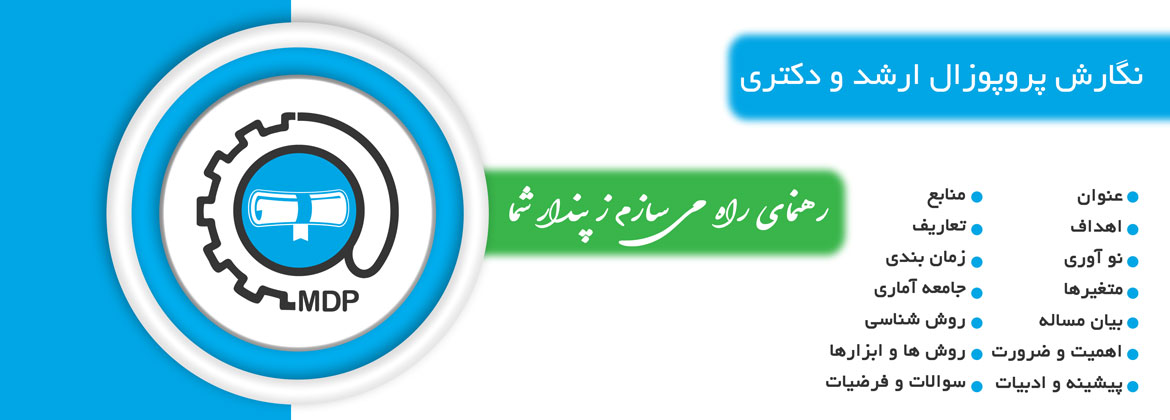
پروپوزال: طرحریزی دقیق برای موفقیت در مسیر پژوهش
در امتداد پیشپروپوزال که به مثابه طرح اولیه و چکیدهای از ایدههای پژوهشی شماست، پروپوزال به عنوان یک طرح تفصیلی و جامع، نقشه راه کامل تحقیقات علمی شما را ترسیم میکند. این سند حیاتی، فراتر از یک معرفی مختصر، تمامی ابعاد پژوهش شما را با دقت و جزئیات کامل تبیین مینماید و هدف آن جلب حمایتهای مالی و تأیید پروژه از سوی نهادهای دانشگاهی، دولتی یا صنعتی است.
در یک پروپوزال کامل، بخشهایی نظیر بررسی جامع ادبیات موضوع (Literature Review)، فرضیات و سوالات تحقیق به صورت مفصل، روششناسی دقیق شامل جزئیات کامل نمونهگیری، ابزارها و تحلیل دادهها، برنامه زمانی اجرایی، تخمین بودجه مورد نیاز و نتایج مورد انتظار به صورت عمیق مورد بحث قرار میگیرند.
پروپوزال، در واقع، نمایانگر فهم کامل شما از مشکل تحقیق و تواناییتان در طراحی و اجرای یک پژوهش اثربخش است.
با توجه به اهمیت بینظیر این سند در مسیر پذیرش و تأمین مالی پژوهشها، موسسه ماد دانش پژوهان (مادینو) با تیمی از متخصصان باتجربه، شما را در نگارش پروپوزالی ساختارمند، علمی و متقاعدکننده یاری میدهد تا پژوهشهای شما با پشتوانه قویتر، گام در عرصه عمل بگذارند.
پیشپروپوزال و پروپوزال: تفاوت در عمق، نه در ماهیت
همانطور که ملاحظه کردید، پروپوزال و پیشپروپوزال تفاوت فاحشی با هم ندارند و تفاوت اصلی آنها در حجم محتوا و ماهیت اطلاعاتی است که در آنها قرار میگیرد.
برای مثال، مباحثی مانند فرضیات دقیق، سوالات تحقیق جزئی، مدل تحقیق کامل و بسیاری از بخشهای اساسی در پروپوزال معمولاً در پیشپروپوزال قرار نمیگیرند، اما مباحثی مانند ضرورت تحقیق، خلاصهای از ادبیات موضوع و نمایی کلی از روش تحقیق به صورت فشرده ارائه میشوند تا چشماندازی روشن در مورد پژوهش برای مخاطب فراهم آورند.
با موسسه ماد دانش پژوهان (مادینو)، پیشفرض موفقیت را از همین حالا بسازید!
نگارش یک پیشپروپوزال قوی و متقاعدکننده، اولین قدم در جلب حمایت و پذیرش پژوهش شماست.
مادینو با تیم حرفهای و تجربه چندین ساله در نگارش و ویرایش پیشپروپوزالها و پروپوزالهای تحقیقاتی در تمامی رشتهها، آماده است تا شما را در این مسیر یاری دهد.
با ما، ایدههای شما نه تنها دیده میشوند، بلکه مورد حمایت قرار میگیرند.
و اینک جان کلام
در فرآیند پژوهش دانشگاهی، بهویژه در مقاطع تحصیلات تکمیلی، دانشجویان معمولاً با دو اصطلاح کلیدی مواجه میشوند: پیشپروپوزال و پروپوزال. این دو مرحله اگرچه شباهتهایی با یکدیگر دارند، اما از نظر هدف، محتوا، و جایگاه در مسیر پژوهش تفاوتهای قابل توجهی دارند. درک درست این تفاوتها باعث میشود دانشجو بتواند مسیر علمی خود را شفافتر و هدفمندتر پیش ببرد.
پیشپروپوزال چیست؟
پیشپروپوزال سندی کوتاه و مقدماتی است که هدف آن ارائهی ایدهی اولیه پژوهش به گروه آموزشی یا استاد راهنماست. در واقع، این سند برای جلب نظر اولیه و بررسی امکانسنجی موضوع نوشته میشود.
ویژگیهای پیشپروپوزال:
-
معمولاً بین ۲ تا ۵ صفحه است.
-
شامل موضوع، بیان مسأله، اهمیت تحقیق، و اهداف کلی میباشد.
-
در این مرحله هنوز روششناسی به صورت کامل تدوین نشده است.
-
زبان آن سادهتر و اجمالیتر از پروپوزال است.
پروپوزال چیست؟
پروپوزال سند رسمی و کاملتری است که پس از تأیید اولیه، توسط دانشجو نوشته میشود تا طرح پژوهش بهطور جامع و دقیق به تصویب برسد.
ویژگیهای پروپوزال:
-
معمولاً بین ۱۰ تا ۲۰ صفحه است.
-
شامل موضوع نهایی، مرور ادبیات تحقیق، روش تحقیق، فرضیات یا پرسشهای پژوهشی، جامعه و نمونه آماری (در صورت وجود)، و منابع است.
-
بهعنوان مرجع اصلی اجرای پایاننامه یا رساله مورد استفاده قرار میگیرد.
-
باید از نظر علمی، روششناختی و نگارشی کاملاً استاندارد باشد.
تفاوتهای اصلی پیشپروپوزال و پروپوزال
| موضوع | پیشپروپوزال | پروپوزال |
|---|---|---|
| حجم و اندازه | کوتاه (۲–۵ صفحه) | بلندتر (۱۰–۲۰ صفحه) |
| هدف | ارائه ایده اولیه | تصویب طرح نهایی پژوهش |
| محتوا | موضوع، بیان مسأله، اهمیت تحقیق | مرور ادبیات، روش تحقیق، فرضیهها، منابع |
| سطح جزئیات | اجمالی و کلی | دقیق و جامع |
| مخاطب | استاد راهنما / گروه آموزشی | شورای پژوهشی / کمیته تخصصی |
| نقش در پژوهش | امکانسنجی و جلب موافقت اولیه | نقشه راه اصلی تحقیق |
اهمیت شناخت تفاوتها
اگر دانشجو تفاوت این دو مرحله را درک نکند، ممکن است در همان آغاز مسیر با مشکلاتی مانند رد شدن موضوع، دوبارهنویسی متعدد، یا تأخیر در تصویب پایاننامه مواجه شود. بنابراین، آشنایی با ساختار و هدف هر دو سند ضروری است.
نتیجهگیری
پیشپروپوزال و پروپوزال دو گام مکمل در مسیر پژوهش دانشگاهی هستند. اولی برای سنجش امکان و جلب موافقت اولیه به کار میرود و دومی بهعنوان طرح جامع پژوهش عمل میکند. دانشجویان موفق کسانی هستند که با دقت و دانش کافی هر دو مرحله را طی میکنند.
همین امروز با مادینو تماس بگیرید و پژوهش خود را با نگارشی قدرتمند به دنیای علم و عمل معرفی کنید!
بخشهای مختلف یک پروپوزال – معیارهای انتخاب عنوان تحقیق – انواع مختلف پروپوزال
موسسه پژوهشی ماد دانش پژوهان (مادینو)
پیش پروپوزال یا (pre-proposal)
یک سند کوتاه تقریبا دو یا سه صفحه ای است که در آن به یک سری سوالات کلی در مورد پروژه شما پاسخ داده می شود. هدف کلی از ارائه پیش پروپوزال قانع کردن مخاطبین به اجرایی بودن، مقرون به صرفه بودن و بااهمیت بودن پژوهش است. تهیه و آماده سازی پیش پروپوزال با توجه به موضوع، رشته و هدف شخص به سه دسته کلی دانشگاهی (آکادمیک-دانشگاهی)، کسب وکار(صنعتی-تجاری-خدماتی) و عمومی (موضوعی) تقسیم بندی می شود.
نگارش پیش پروپوزال بسیار اهمیت دارد چرا که اگر محتوای نگارش شده در آن قابل استناد، قابل توجیه و قابل اجرا نباشند در نهایت پروژه شما مورد تایید قرار نگرفته و رد خواهد شد. موسسه ماد دانش پژوهان تمامی فرآیندهای مربوط به نگارش پیش پروپوزال را با کیفیتی بسیار بالا برای شما دانشجویان، پژوهشگران و صاحبان صنعت انجام خواهد داد.
شماره تماس: 09102340118 ثبت سریع سفارش ![]()
![]()
پیش پروپوزال موضوعی
پیش پروپوزال موضوعی یک طرح پیشنهادی مختصر مرتبط با یک عنوان خاص است که دید کلی به مخاطب در یک حوزه مشخص خواهد داد. فرآیند آماده سازی پیش پروپوزال موضوعی نسبت به پروپوزال آن کمی ساده تر بوده و نیاز به ارائه توضیح مختصری از یکسری سرفصل های تعیین شده دارد. در پیش پروپوزال موضوعی 4 بخش اصلی را گنجانده و در هر بخش توضیح مختصری را ارائه می کنید تا در صورت متقاعد کردن مخاطب بتوانید با نگارش پروپوزال موضوعی توضیحات تکمیلی را ارائه نمایید.
لازم به ذکر است که برای نگارش پروپوزال موضوعی نیاز است که بخش های جدیدی را به آن بیافزایید.چهار بخش اصلی پیش پروپوزال موضوعی عبارتند از Summary یا خلاصه موضوعی، Organizational Information یا اطلاعات سازمانی، Problem and Work Plan مشکل و برنامه عملیاتی و در نهایت Budget یا بودجه بندی است. نگارش تمامی این چهار بخش به گونه ای مختصر و متقاعد کننده برای مخاطب کار بسیار دشواری است و نیاز به مشورت و همکاری با یک متخصص دارد. توصیه می شود برای نگارش پیش پروپوزال و پروپوزال موضوعی حتما از نظرات یک متخصص بهره ببرید.
شماره تماس: 09102340118 ثبت سریع سفارش ![]()
![]()
پیش پروپوزال آکادمیک- دانشگاهی
پیش پروپوزال آکادمیک و دانشگاهی بسیار شبیه به سایر تحقیقات و مطالعات دانشگاهی بوده و یک ساختار استاندارد و مشخص خواهد داشت. پیش پروپوزال دانشگاهی یک طرح پیشنهادی کوتاه و مختصر پیش از ارائه پروپوزال و پایان نامه است. پیش پروپوزال آکادمیک که به آن White paper نیز گفته می شود، یک طرح پیشنهادی 7 یا 8 صفحه ای است که در آن به صورت مختصر به مباحثی مانند سوالات و فرضیات تحقیق، ادبیات موضوع، فرآیند روش تحقیق و رفرنس دهی پرداخته می شود.
در بسیاری از دانشاه های معتبر جهان، خصوصا در مقطع دکتری، سابمیت و ارائه پیش پروپوزال با توافق استاد راهنما پیش از ارائه پروپوزال امری اجباری است.برای نگارش پیش پروپوزال سعی کنید در بخش ادبیات موضوع، به طور خلاصه یک یا چند فرضیه را مطرح کرده و با ارائه مطالب مرتبط دلیل اصلی مطرح شدن فرضیات را مشخص نمایید. در بخش روش تحقیق نیز لزومی وجود ندارد جزئیات مربوط به ابزار و روش گردآوری داده ها را مطرح کنید و تنها باید دلیل انتخاب این ابزار و روش ها را مختصرا تشریح نمایید. در صورتی که پروژه شما نیاز به بودجه یا طرح حمایتی خاصی دارد، سعی کنید در بخش انتهایی پیش پروپوزال قبل از رفرنس دهی این موضوع را بطور شفاف بیان کنید.
شماره تماس: 09102340118 ثبت سریع سفارش ![]()
![]()
پیش پروپوزال صنعتی- تجاری- خدماتی
پیش پروپوزالی که برای مقاصد تجاری، صنعتی و خدماتی آماده می شود تا حد زیادی با پیش پروپوزال دانشگاهی متفاوت است. بر این اساس پیش پروپوزال صنعتی با هدف قانع کردن کارفرما و یا صاحب اصلی پروژه نگارش می شود. معمولا مواردی که در پیش پروپوزال صنعتی، تجاری و یا خدماتی بیان می شوند شامل زمان بندی انجام پروژه، بودجه پیش بینی شده برای هر مرحله، فرآیند و نحوه پیاده سازی پروژه، محل و موقعیت انجام پروژه و پتانسیل ها و نقاط مثبت این محل بگونه ای که هزینه ها را توجیه کند و در نهایت زمان تحویل پروژه است.نگارش پیش پروپوزال برای مقاصد تجاری و صنعتی بسیار دشوارتر بوده و به دلیل بالا بودن میزان رقابت، در صورتی که پیش پروپوزال شما به روش قانع کننده ای نگارش نشود، امکان از دست دادن پروژه بسیار بالا خواهد بود.
شماره تماس: 09102340118 ثبت سریع سفارش ![]()
![]()
[icebutton link="https://118daneshgah.com/index.php?option=com_content&view=article&id=1066:سفارش-سریع&catid=2:uncategorised&Itemid=838" type="btn"]ثبت
سفارش[/icebutton]
پیش پروپوزال یا (pre-proposal) یک سند کوتاه تقریبا دو یا سه صفحه ای است که در آن به یک سری سوالات کلی در مورد پروژه شما پاسخ داده می شود. هدف کلی از ارائه پیش پروپوزال قانع کردن مخاطبین به اجرایی بودن، مقرون به صرفه بودن و بااهمیت بودن پژوهش است. تهیه و آماده سازی پیش پروپوزال با توجه به موضوع، رشته و هدف شخص به سه دسته کلی دانشگاهی (آکادمیک-دانشگاهی)، کسب وکار(صنعتی-تجاری-خدماتی) و عمومی (موضوعی) تقسیم بندی می شود. نگارش پیش پروپوزال بسیار اهمیت دارد چرا که اگر محتوای نگارش شده در آن قابل استناد، قابل توجیه و قابل اجرا نباشند در نهایت پروژه شما مورد تایید قرار نگرفته و رد خواهد شد. موسسه ماد دانش پژوهان تمامی فرآیندهای مربوط به نگارش پیش پروپوزال را با کیفیتی بسیار بالا برای شما دانشجویان، پژوهشگران و صاحبان صنعت انجام خواهد داد.
موضوعی
آکادمیک- دانشگاهی
صنعتی- تجاری- خدماتی
موتیو نیوز
مقاله بیس
فلسفه انتخاب مقاله بیس از آن جا نشات می گیرد که قبل از انتخاب موضوع، مقاله پایه ای در نظر گرفته شود که ساختار آن پژوهش را از ابتدا تا انتها مشخص کرده باشد. یک مقاله بیس خوب به پژوهشگران کمک می کند تا برای مشخص کردن ساختار و طرح پژوهش یا مقاله خود از آن استفاده کنند.
در واقع یک مقاله بیس مناسب مشکلات احتمالی در هنگام نگارش طرح پژوهشی و پروپوزال، پایان نامه یا مقاله را برطرف خواهد کرد. یک مقاله بیس مناسب یک مرجع دست اول به شمار می رود که روند حل یک مسئله را مشخص ساخته و حل یک معما را برای پژوهشگر راحت تر کرده است. در حال حاضر در بسیاری از دانشگاه ها و مراکز علمی و پژوهشی در هنگام ارائه عنوان پژوهش، پژوهشگران ملزم به ارائه مقالات بیس یا پایه نیز می باشند.
چرا که مقاله بیس ساختار و روال فرایندی یک پژوهش را مشخص کرده است. اما یکی از مشکلاتی که برای پژوهشگران در هنگام انتخاب مقاله بیس رخ می نماید نداشتن سنجه ها و ملا ک های دقیق برای انتخاب یک مقاله بیس مناسب است.
برای یافتن مقاله پایه مناسب و کارا بهتر است جستجوی خود را حساب شده و با مهارت کافی انجام دهیم تا به نتیجه مطلوب تری برسیم. در واقع برای انجام این کار مقدمات و ملزوماتی هست که بهتر است لحاظ شوند. توجه به تک تک کلید واژه ها در عنوان جستجو ضرورت دارد و گاهی کلمات کلیدی معادل هم می توانند جایگزین کلمات اصلی در جستجوی ما باشند.
ترکیب کلمات کلیدی با هم به طور درست و موثر نکته دیگری است که باید توجه کافی به آن لحاظ شود و در واقع نوع ترکیب بندی روی نتیجه جستجوی ما موثر است.
موتور جستجوی انتخابی می تواند موتورهای مختلفی باشد از جمله google و bing و...و نتایج این جستجوها در موتورهای مختلف الزاما یکی نیستند. نوع جستجو و مهارت وب گردی خود نکته ظریف دیگری است.
تسلط شما به مبحث مورد جستجو و کلید واژه های آن از دیگر مهارت های موثر این مقوله است. کنجکاوی زیاد و دقیق و مشورت با اصحاب فن در مورد کلید واژه های مورد جستجو بسیار مفید و سودمند است. تسلط به زبان انگلیسی یا زبانی که در بستر آن وب گردی می کنید نیز مبحث خیلی مهمی است. تیز بودن چاقوی شما همان به روز بودن ابزارهای سخت افزاری و نر افزاری شماست که بهتر است در این مورد با آن تعارف نکنید و حتما چاقوی شما تیز باشد.
در ذیل اشاره ای به سنجه ها و ملاک های مناسب برای انتخاب مقاله پایه خواهیم داشت:
۱- ابتدا به این نکته توجه کنید که مقالاتی را باید انتخاب کنید که در پایگاه های علمی معتبر آرشیو شده باشند. اشتباهی که برخی از پژوهشگران مرتکب می شوند این است که با مراجعه به گوگل یا وب سایت های غیر معتبر به دنبال مقاله بیس گشته و به سرعت یک مقاله نامطلوب و غیر علمی را به عنوان مقاله پایه انتخاب می کنند. باید به این نکته اشاره کنیم که اساتید و گروه های آموزشی شما به خوبی به پایگاه های معتبر آشنا هستند و در صورتی که مقالات از این پایگاه ها نباشند آن ها را نخواهند پذیرفت. حتما مقالات بیس خود را از پایگاه های معتبری همچون:
IEEE
JSTOR
Emerald
Springer
Science Direct
Cambridge Journals
و یا همانند آن ها، انتخاب فرمایید.
۲- عنوان مقاله ای که انتخاب می کنید نباید حداقل در پژوهش های داخلی به صورت مقاله یا پایان نامه انجام شده و ثبت شده باشد. برای این کار بعد از انتخاب عنوان به سایت ایران داک و حتی گوگل مراجعه کنید و عنوان خود را در آنجا چک کنید تا قبلا کار نشده باشد.
۳- حتما به سال نشر مقاله بیس توجه کنید. مقاله ای را انتخاب کنید که حداکثر دو سال با زمان فعلی فاصله داشته باشد . به عبارت دیگر سال مقاله بیس هرچه قدر جدیدتر باشد امکان پذیرش آن از سوی استاد راهنما و مشاور بیشتر خواهد بود.
۴- حتما به این نکته توجه کنید که داده های مقاله بیس انتخابی در داخل کشور نیز قابل گردآوری باشد یا امکان انجام آن در داخل نیز وجود داشته باشد. برای این کار دقت کنید داده های مقاله یا در دسترس می باشد و یا اینکه به لحاظ ساختار امکان انجام آن در ایران وجود داشته باشد.
۵- در رشته هایی که گردآوری داده ها با پرسشنامه صورت می گیرد سعی کنید پرسشنامه ها در مقاله ضمیمه شده باشد یا اینکه پرسشنامه های استفاده شده در مقاله بیس از مقالات دیگر قابل استخراج باشد. یعنی به شکلی نباشد که پرسشنامه های مقاله بیس به هیچ وجه یافت نشود.
۶- فرایند طی شده در تحقیق یعنی اهداف، مدل مفهومی، نحوه شبیه سازی، نرم افزار استفاده شده و نحوه گردآوری داده ها در مقاله مشخص شده باشد. این کار طی فرایند پژوهش را برای شما آسان و ممکن خواهد کرد و از مشکلات متعدد رها خواهد ساخت.
شبیه سازی - مستند سازی - جستجوی قوی با گوگل - مقاله بیس - انتخاب ژورنال
شماره تماس: 09102340118 ثبت سریع سفارش ![]()
![]()


